西方经济学名词英文缩写修订稿
- 格式:docx
- 大小:55.46 KB
- 文档页数:8
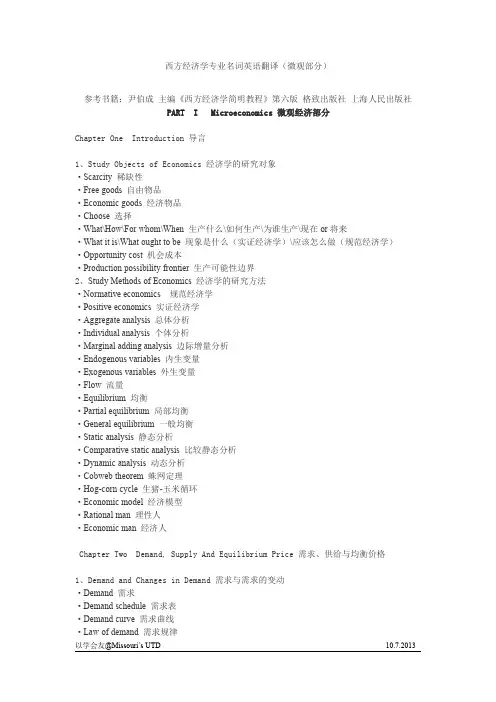
西方经济学专业名词英语翻译(微观部分)参考书籍:尹伯成主编《西方经济学简明教程》第六版格致出版社上海人民出版社PART I Microeconomics微观经济部分Chapter One Introduction导言1、Study Objects of Economics经济学的研究对象·Scarcity稀缺性·Free goods自由物品·Economic goods经济物品·Choose选择·What\How\For whom\When生产什么\如何生产\为谁生产\现在or将来·What it is\What ought to be现象是什么(实证经济学)\应该怎么做(规范经济学)·Opportunity cost机会成本·Production possibility frontier生产可能性边界2、Study Methods of Economics经济学的研究方法·Normative economics规范经济学·Positive economics实证经济学·Aggregate analysis总体分析·Individual analysis个体分析·Marginal adding analysis边际增量分析·Endogenous variables内生变量·Exogenous variables外生变量·Flow流量·Equilibrium均衡·Partial equilibrium局部均衡·General equilibrium一般均衡·Static analysis静态分析·Comparative static analysis比较静态分析·Dynamic analysis动态分析·Cobweb theorem蛛网定理·Hog-corn cycle生猪-玉米循环·Economic model经济模型·Rational man理性人·Economic man经济人Chapter Two Demand,Supply And Equilibrium Price需求、供给与均衡价格1、Demand and Changes in Demand需求与需求的变动·Demand需求·Demand schedule需求表·Demand curve需求曲线·Law of demand需求规律·Giffen goods吉芬商品·Substitute effect替代效应·Substitute goods互替商品·Income effect收入效应·Taste偏好·Income收入·Complementary goods互补商品·Expectation预期·Demand function需求函数2、Supply and Changes in Supply供给与供给变动·Supply供给·Supply schedule供给表·Supply curve供给曲线·Law of supply供给规律·Supply function供给函数3、Theory of Elasticity of Demand and Supply需求和供给的弹性理论·Elasticity弹性·Elasticity of demand需求弹性·Elasticity of supply供给弹性4、Equilibrium Price均衡价格·Equilibrium quantity均衡交易量(均衡数量)5、Cobweb Model蛛网模型Chapter Three Theory Of Consumer Behavior消费者行为理论1、Theory of Cardinal Utilities基数效用论·Utility效用·Average utility(AU)平均效用·Marginal utility(MU)边际效用2、Theory of Ordinal Utilities序数效用论·Indifference curve无差异曲线·Marginal rate of substitution边际替代率·Budget line预算线3、Intertemporal Choice跨时期选择4、Consumer Behavior under Uncertainty不确定情况下消费者行为Chapter Four Theory Of Firm And Production企业和生产理论1、The Firm and Its Object企业及其目标·Firm厂商·Corporate social responsibility(CSR)企业社会责任2、Production Function生产函数·Factor of production生产函数·Technological coefficient技术系数3、Short-run Production Function短期生产函数·Total product总产量·Average product平均产量·Marginal product边际产量·Law of diminishing marginal return边际收益递减规律4、Long-run Production Function长期生产函数·Isoquant curve等产量曲线·Marginal rate of technical substitution(MRTS)生产要素的边际替代率·Isocost curve等成本曲线·Expansion path扩展线5、Return to Scale规模报酬·Increasing return to scale规模报酬递增·Constant return to scale规模报酬不变·Diminishing return to scale规模报酬递减·Economics of scale规模经济·Economics of scope范围经济Chapter Five Cost Theory成本理论1、Cost and Cost Function成本与成本函数·Opportunity cost机会成本·Explicit cost显性成本·Implicit cost隐性成本2、Short-run Cost短期成本·Fixed cost固定成本·Variable cost(VC)可变成本·Total cost(TC)总成本·Average fixed cost(AFC)平均固定成本·Average variable cost(AVC)平均可变成本·Marginal cost(MC)边际成本3、Long-run Cost长期成本·Long-run total coat长期总成本·Short-run total cost短期总成本·Envelop curve包络线·Long-run average cost长期平均成本Chapter Six Price and Quantity Determination in Perfect Competition and Monopoly 完全竞争和完全垄断市场中的价格和产量的决定1、Some Concepts Concerning Behavior of the Firms有关厂商行为的几个概念·Market市场·Industry产业·Total revenue(TR)总收益·Average revenue(AR)平均收益·Marginal revenue(MR)边际收益2、Price and Quantity Determination in Perfect Competition完全竞争市场中价格和产量的决定·Increasing-cost industry成本递增行业·Decreasing-cost industry成本递减行业·Constant-cost industry成本不变行业3、Price and Quantity Determination in Monopoly完全垄断市场中价格和产量的决定·Monopoly垄断·Price discrimination价格歧视·Monopoly power垄断势力·Market segmentation市场分割·Multi-part pricing多重价格·Perfect discrimination price完全差别定价·Third-degree price discrimination三级价格歧视·Second-degree price discrimination二级价格歧视Chapter Seven Price And Quantity Determination in Mono-Polistic Competition and Oligopoly垄断竞争市场与寡头垄断市场中价格和产量的决定1、Price and Quantity Determination in Monopolistic Competition垄断竞争市场中价格和产量的决定·Monopolistic competition垄断竞争·Product differentiation产品差别·Selling costs销售成本2、Price and Quantity Determination in Oligopoly寡头垄断市场中价格和产量的决定·Oligopoly寡头垄断·Reaction function反应函数·Kinded demand curve拐折需求曲线·Price leadship价格领导·Barometric firm晴雨表型厂商·Cost-plus pricing成本加成定价Chapter Eight Game Theory And Economics Of Information博弈论和信息经济学1、Game theory博弈论·Player局中人·Strategy策略·Strategyset策略集合·Payoff收益2、Economics of Information信息经济学Chapter Nine The Price of Factor And Income Distribution要素价格与收入分配1、Demand for Production Factors生产要素的需求·Derived demand派生需求·Joint demand联合需求·Marginal productivity边际生产力·Marginal physicl product(MPP)边际物质产品·Marginal revenue product(MRP)边际收益产品·Marginal factor cost(MFC)边际要素成本·Value of the marginal product(VMP)边际产品价值2、Supply of Factors and the Price Determination生产要素的供给和价格决定3、Differences between Poor and Rich贫富差别·Lorenz curve洛伦茨曲线·Gini coefficient基尼系数Chapter Ten General Equilibrium And Welfare Economics一般均衡与福利经济学1、General Equilibrium一般均衡2、Pareto Optimum帕累托最优·Edgeworth-box diagram艾奇沃斯盒形图·Exchange contract curve交换契约线·Production contract curve生产契约线·Production possibility frontier生产可能性曲线·Marginal rate of product transformation(MRPT)边际转换率3、Welfare Economics福利经济学Chapter Eleven Policies in Microeconomy微观经济政策·Market failure市场失灵1、Monopoly and Anti-monopoly Policy垄断和反垄断政策·《Sherman Antitrust Act(1890)》谢尔曼反托拉斯法·《Clayton Antitrust Act(1914)》克莱顿反托拉斯法·《Celler-Kafauver Act(1950)》塞勒-凯佛维尔法2、Externality外部影响·Positive externality积极的外部影响·Negative externality消极的外部影响·Private cost私人成本·Social cost社会成本·Coase's Theorem科斯定理3、Public Goods公共物品·Private goods私人物品·Free rider4、Public Choice公共选择以上涉及到的部分经济学家:·Abraham Maslow[英]马歇尔·Adam Smith[英]亚当·斯密·Leon Walras[法]瓦尔拉斯·Augustin Cournot[法]古诺·Stackelberg,Heinrich Von[德]斯塔克伯·Josh Nash[美]纳什·V.pareto[意]帕累托西方经济学专业名词英语翻译(宏观部分)参考教材:尹伯成主编《西方经济学简明教程》第六版格致出版社上海人民出版社PART II Macroeconomics宏观观经济部分Chapter twelve National Income Accounting国民收入核算1、Concept of Gross Domestic Products国内生产总值的概念·Gross domestic product(GDP)国内生产总值·Nominal GDP名义国内生产总值·Real GDP实际国内生产总值·Final goods最终产品·Service服务·Intermediate products中间产品·value added新增价值·Input-output transaction table投入-产出转换表·Gross national product(GNP)国民生产总值2、Principles of National Income Measurement有关核算国民收入的基本原理·Leakage漏出·Injection注入3、Two Ways of National Income Measurement核算国民收入的两种基本方法·Fixed investment固定资产投资·Inventory investment存货投资·Transfer payment转移支付·Export(X)出口·Import(M)进口·Net export净出口·Net domestic product(NDP)国内生产净值·Net national product(NNP)国民生产净值·National income(NI)国民收入·Personal income(PI)个人收入·Disposable personal income(DPI)个人可支配收入·Net factor income from abroad国外要素所得净额4、Identities in National Income Accounting国民收入核算中的恒等关系Chapter Thirteen National Income Determination:Income Expenditure Model国民收入的决定:收入-支出模型1、Concepts of Macro-equilibrium宏观均衡的概念2、Consumption Function消费函数3、Deciding of National Income of Two-sector Economy两部门经济国民收入的决定4、National Income Determinations in Three-sector and Four-sector Economies三部门和四部门经济国民收入的决定5、Potential National Income and Its Gap潜在国民收入与缺口·GDP gap国内生产总值缺口Chapter Fourteen Money,Interest Rate and National Income货币、利息和国民收入1、Money and Money Supply货币和货币供给·Automatic Transfer Service(ATS)自动转账账户·Negotiable Orders of Withdrawal(NOW)可转让的提款单·Legal reserve ratio法定准备率2、Money Demand货币的需求·The transaction motive交易动机·The precautionary motive预防动机·The speculative motive投机动机3、Interest Rate,Investment and National Income利率、投资和国民收入·Marginal efficiency of investment(MEI)投资的边际效率4、Financial Market金融市场Chapter Fifteen National Income Determination IS-LM Model国民收入的决定:IS-LM 模型1、Equilibrium in Goods Market and the IS Curve产品市场的均衡与IS曲线2、Equilibrium in Money Market and the LM Curve货币市场的均衡与LM曲线3、Equilibrium both in Goods and Money Markets and IS-LM Model产品市场和货币市场的同时均衡与IS-LM模型Chapter Sixteen Fiscal Policy And Monetary Policy财政政策和货币政策1、Fiscal Policy and Its Effects财政政策及其效果·Automatic stabilizers自动稳定期·Expansionary fical policy扩张性财政政策·Discretionary fiscal policy紧缩性财政政策·Discretionary fiscal policy相机抉择的财政政策·Effectiveness of crowding out挤出效应·National debt公债2、Monetary Policy and Its Effects货币政策及其效果3、Mixture of Fiscal Policy and Monetary Policy财政政策和货币政策的混合Chapter Seventeen The Deciding of National Income:AD-AS Model国民收入的决定:总需求-总供给模型1、Aggregate Demand Function总需求函数·Aggregate demand curve总需求曲线·Aggregate expenditure总支出曲线·Interest-rate-effect利率效应·Real-balance-effect实际余额效应2、Aggregate Supply Function总供给函数·Aggregate supply curve总供给曲线·Stagflation滞涨3、AD-AS Model总供给-总需求模型Chapter Eighteen Inflation And Unemployment通货膨胀与失业1、Inflation通货膨胀·Consumer price index(CPI)消费价格指数·Producer price index(PPI)生产者价格指数·Demand-pull inflation需求拉上的通货膨胀·Cost-push inflation成本推进的通货膨胀·Redistribution effects of inflation通货膨胀的再分配效应·Output effects of inflation通货膨胀的产出效应·Hyperinflation极度膨胀2、Unemployment失业·Frictional unemployment摩擦性失业·Seasonal unemployment季节性失业·Cyclical unemployment周期性失业·Demand-deficient unemployment需求不足型失业·Technical unemployment技术性失业·Structural unemployment结构性失业·Voluntary unemployment自愿失业·Involuntary unemployment非自愿失业·Natural rate of unemployment自然失业率·Full-time job全日制工作·Part-time job打短工·Underemployment不充分就业(未充分利用技能)3、Trade-offs Between Inflation and Unemployment通货膨胀和失业的联系·incomes policy收入政策Chapter Nineteen Economic Growth,Economic Development And Economic Cycle经济增长、经济发展与经济周期1、Economic Growth经济增长2、Economic Development经济发展3、Economic Cycle经济周期·Business cycle经济周期、经济波动·Turning point转折点·Trough谷底·Expansion扩张·Peak峰顶·Recession衰退·Juglar Cycles中周期(9、10年)、朱拉格周期·Kitchen Cycles短周期(4、5年)、基钦周期·Kondratief Cycles长周期(50年)、康德拉季耶夫周期·Kuznets Cycles长周期(20年)、库兹涅茨周期Chapter Twenty Basics of International Economics国际经济学初步1、International Trade国际贸易·Comparative advantage2、Exchange Rate and Exchange Rate System汇率与汇率制度·Exchange rate汇率·Fixed rate system固定汇率制度·Floating rate system浮动汇率制度/Dirty rate system不洁净汇率制度3、International Payments and Adjustment国际收支及其调整·Balance of payments国际收支平衡表·Current account经常项目·Visible account有形项目·Traded service account贸易劳务项目·Capital servicing account资本服务项目4、Policy Effects in Open Economy开放经济中的政策效果以上涉及到的部分经济学家:·Abraham Maslow[英]马歇尔·Adam Smith[英]亚当·斯密·Leon Walras[法]瓦尔拉斯·Augustin Cournot[法]古诺·Stackelberg,Heinrich Von[德]斯塔克伯·Josh Nash[美]纳什·V.pareto[意]帕累托·J.S Duesenberry[美]杜森贝利·Milton Friedman[美]米尔顿·弗里德曼·F.Modigliani[美]弗朗科·莫迪利安尼·D.Cagan[美]卡根·A.W.Philips[新西兰]菲利普斯·Lipsey[英]利浦赛·E.F.Dennison[美]丹尼森·E.J.Mishan[英]米香·D.H.Meadows[美]麦多斯·D.Ricardo[英]大卫·李嘉图·E.Heckcher[瑞典]赫克歇林·B.Ohlin[瑞典]奥林·R.Prebisch[阿根廷]普雷维什。

西方经济学名词英文缩写第2章D Demand 需求S Supply 供给P Price 价格Q Quantity 数量Ed Price elasticity of demand 需求价格弹性EM income elasticity of demand 需求收入弹性M money 收入EAB Cross price elasticity of demand 需求交叉价格弹性Es Price elasticity of supply 供给价格弹性第3章 TU Total utility 总效用 TU=f(Q)MU Marginal utility 边际效用MRSXY Marginal rate of substitution 商品边际替代率第4章 L Labour 劳动K Capital 资本TC total cost 总成本 TC=f(Q) 4.1AC average cost 平均成本MC marginal cost 边际成本FC Fixed cost 不变成本 FC=常量 4.4VC Variable cost 可变成本 VC=f(Q) 4.5TR Total revenue 总收益 TR=f(Q)=P×QAR Average revenue 平均收益MR Marginal revenue 边际收益π利润π=TR-TC 4.6TP Total product 总产量 TP=f(L) 4.7AP Average product 平均产量MP Marginal product 边际产量MRTSLK Marginal rate of technical substitution 边际技术替代率STC Short-run total cost 短期总成本 STC=f(Q)=FC+VCSTFC(FC) Short-run total fixed cost 短期总不变成本(固定成本) STFC=常量STVC(VC) Short-run total variable cost 短期总可变成本(可变成本) STVC=f(Q) SAC(ATC) Short-run average cost 短期平均成本SAFC(AFC) Short-run average fixed cost (短期)平均固定成本SAVC(AVC) Short-run average variable cost (短期)平均可变成本SMC Short-run marginal cost 短期边际成本LTC Long-run total cost 长期总成本 LTC=f(Q)LAC Long-run average cost 长期平均成本LMC Long-run marginal cost 长期边际成本第6章 VMP Value of marginal product 边际产品价值MRP Marginal revenue product 边际收益产量W Wage 工资第9章 GDP Gross demestic product 国内生产总值C Consumption 消费 C=f(Y)=C0+bY 9.1I Investment 投资G Government payment 政府购买NX Net export 净出口 NX=X-MX export 出口M import 进口NDP Net domestic product 国内生产净值NI National income 国民收入PI Personal income 个人收入PDI Personal disposable income 个人可支配收入GNP Gross national product 国民生产总值第10章 Y 总量APC Average propensity to consumption 平均消费倾向MPC marginal propensity to consumption 边际消费倾向S Save 储蓄APS Average propensity to save 平均储蓄倾向MPS marginal propensity to save 边际储蓄倾向AD Aggregate demand 总需求 AD=C+I+G+XAS Aggregate supply 总供给 AS=C+S+T+MT tax 税收K multiplier 乘数第11章 MEC Marginal efficiency of capital 资本边际效率L Demand for money 货币需求 L=L1(Y)+L2(R)R Rate 利率M Money supply 货币供给第13章 CPI Consumer price index 消费物价指数第14章 KG Government expenditure multiplier 政府购买支出乘数KTR Transfer payment multiplier 转移支付乘数 14.2TR transfer 转移支付KT Tax multiplier 税收乘数KB Balanced budget multiplier 平衡预算乘数第15章 Mh Money base 基础货币(高能货币) Mh=M0+RE 15.1 Ke Deposit expansion multiplier 存款乘数Km Money multiplier 货币乘数第16章 M import 进口 M=M0+mYKX Foreign trade multiplier 对外贸易乘数第17章 G rate of growth 经济增长率Gt 实际增长率Gw Warranted rate of growth 合意增长率Gn Nature rate of growth 实际增长率。
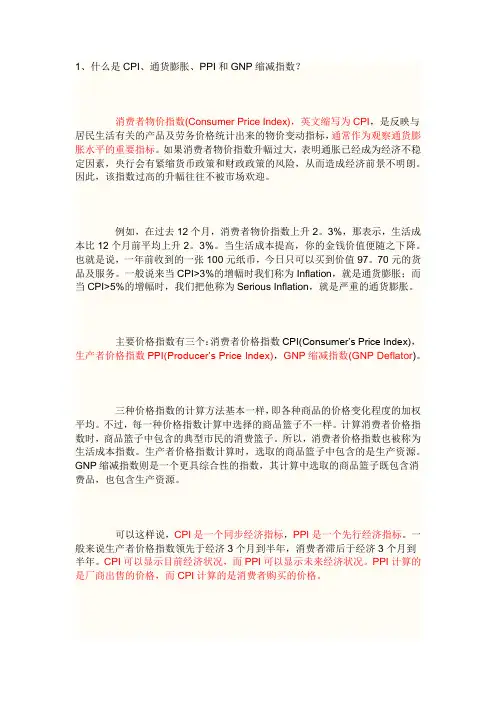
1、什么是CPI、通货膨胀、PPI和GNP缩减指数?消费者物价指数(Consumer Price Index),英文缩写为CPI,是反映与居民生活有关的产品及劳务价格统计出来的物价变动指标,通常作为观察通货膨胀水平的重要指标。
如果消费者物价指数升幅过大,表明通胀已经成为经济不稳定因素,央行会有紧缩货币政策和财政政策的风险,从而造成经济前景不明朗。
因此,该指数过高的升幅往往不被市场欢迎。
例如,在过去12个月,消费者物价指数上升2。
3%,那表示,生活成本比12个月前平均上升2。
3%。
当生活成本提高,你的金钱价值便随之下降。
也就是说,一年前收到的一张100元纸币,今日只可以买到价值97。
70元的货品及服务。
一般说来当CPI>3%的增幅时我们称为Inflation,就是通货膨胀;而当CPI>5%的增幅时,我们把他称为Serious Inflation,就是严重的通货膨胀。
主要价格指数有三个:消费者价格指数CPI(Consumer’s Price Index),生产者价格指数PPI(Producer’s Price Index),GNP缩减指数(GNP Deflator)。
三种价格指数的计算方法基本一样,即各种商品的价格变化程度的加权平均。
不过,每一种价格指数计算中选择的商品篮子不一样。
计算消费者价格指数时,商品篮子中包含的典型市民的消费篮子。
所以,消费者价格指数也被称为生活成本指数。
生产者价格指数计算时,选取的商品篮子中包含的是生产资源。
GNP缩减指数则是一个更具综合性的指数,其计算中选取的商品篮子既包含消费品,也包含生产资源。
可以这样说,CPI是一个同步经济指标,PPI是一个先行经济指标。
一般来说生产者价格指数领先于经济3个月到半年,消费者滞后于经济3个月到半年。
CPI可以显示目前经济状况,而PPI可以显示未来经济状况。
PPI计算的是厂商出售的价格,而CPI计算的是消费者购买的价格。
2、什么是恩格尔系数?1857年,德国统计学家恩格尔在研究了当时西欧某些居民家庭的收入和食物消费支出的关系后,提出了这样一个观点:一个家庭收入越少,总支出中用来购买食物的费用所占的比例越大。

西方经济学名词英文缩写Document number:NOCG-YUNOO-BUYTT-UU986-1986UT第2章D Demand 需求??S Supply 供给??P Price 价格Q Quantity 数量??Ed Price elasticity of demand 需求价格弹性??EM income elasticity of demand 需求收入弹性??M money 收入??EAB Cross price elasticity of demand 需求交叉价格弹性?? Es Price elasticity of supply 供给价格弹性??第3章 TU Total utility 总效用 TU=f(Q)MU Marginal utility 边际效用??MRSXY Marginal rate of substitution 商品边际替代率?? 第4章 L Labour 劳动??K Capital 资本??TC total cost??总成本 TC=f(Q)AC average cost 平均成本??MC marginal cost 边际成本??FC Fixed cost 不变成本 FC=常量VC Variable cost??可变成本 VC=f(Q)TR Total revenue 总收益 TR=f(Q)=P×QAR Average revenue??平均收益??MR Marginal revenue 边际收益??π??利润π=TR-TCTP Total product 总产量 TP=f(L)AP Average product 平均产量??MP Marginal product 边际产量??MRTSLK Marginal rate of technical substitution 边际技术替代率??STC Short-run total cost??短期总成本 STC=f(Q)=FC+VCSTFC(FC) Short-run total fixed cost 短期总不变成本(固定成本) STFC=常量STVC(VC) Short-run total variable cost??短期总可变成本(可变成本) STVC=f(Q) SAC(ATC) Short-run average cost 短期平均成本??SAFC(AFC) Short-run average fixed cost (短期)平均固定成本??SAVC(AVC) Short-run average variable cost (短期)平均可变成本??SMC Short-run marginal cost 短期边际成本??LTC Long-run total cost 长期总成本 LTC=f(Q)LAC Long-run average cost 长期平均成本??LMC Long-run marginal cost 长期边际成本??第6章 VMP Value of marginal product 边际产品价值?? MRP Marginal revenue product 边际收益产量? ?W Wage??工资??第9章 GDP Gross demestic product 国内生产总值??C Consumption 消费 C=f(Y)=C0+bYI Investment 投资??G Government payment 政府购买??NX Net export 净出口 NX=X-MX export 出口??M import 进口??NDP Net domestic product 国内生产净值??NI National income 国民收入??PI Personal income 个人收入??PDI Personal disposable income 个人可支配收入?? GNP Gross national product??国民生产总值??第10章 Y??总量??APC Average propensity to consumption 平均消费倾向??MPC marginal propensity to consumption 边际消费倾向??S Save 储蓄??APS Average propensity to save 平均储蓄倾向??MPS marginal propensity to save 边际储蓄倾向??AD Aggregate demand 总需求 AD=C+I+G+XAS Aggregate supply 总供给 AS=C+S+T+MT tax 税收??K multiplier 乘数??第11章 MEC Marginal efficiency of capital 资本边际效率??L Demand for money 货币需求 L=L1(Y)+L2(R)R Rate??利率??M Money supply 货币供给??第13章 CPI Consumer price index 消费物价指数??第14章 KG Government expenditure multiplier 政府购买支出乘数?? KTR Transfer payment multiplier 转移支付乘数? ?TR transfer 转移支付??KT Tax multiplier 税收乘数? ?KB Balanced budget multiplier 平衡预算乘数? ?第15章 Mh Money base 基础货币(高能货币) Mh=M0+REKe Deposit expansion multiplier 存款乘数??Km Money multiplier 货币乘数??第16章 M import 进口 M=M0+mYKX Foreign trade multiplier 对外贸易乘数?? 第17章 G rate of growth 经济增长率?? Gt??实际增长率??Gw Warranted rate of growth 合意增长率?? Gn Nature rate of growth 实际增长率。
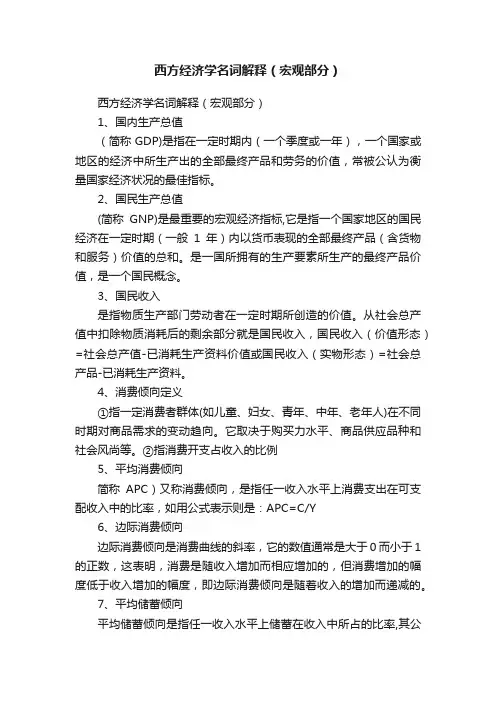
西方经济学名词解释(宏观部分)西方经济学名词解释(宏观部分)1、国内生产总值(简称GDP)是指在一定时期内(一个季度或一年),一个国家或地区的经济中所生产出的全部最终产品和劳务的价值,常被公认为衡量国家经济状况的最佳指标。
2、国民生产总值(简称GNP)是最重要的宏观经济指标,它是指一个国家地区的国民经济在一定时期(一般1年)内以货币表现的全部最终产品(含货物和服务)价值的总和。
是一国所拥有的生产要素所生产的最终产品价值,是一个国民概念。
3、国民收入是指物质生产部门劳动者在一定时期所创造的价值。
从社会总产值中扣除物质消耗后的剩余部分就是国民收入,国民收入(价值形态)=社会总产值-已消耗生产资料价值或国民收入(实物形态)=社会总产品-已消耗生产资料。
4、消费倾向定义①指一定消费者群体(如儿童、妇女、青年、中年、老年人)在不同时期对商品需求的变动趋向。
它取决于购买力水平、商品供应品种和社会风尚等。
②指消费开支占收入的比例5、平均消费倾向简称APC)又称消费倾向,是指任一收入水平上消费支出在可支配收入中的比率,如用公式表示则是:APC=C/Y6、边际消费倾向边际消费倾向是消费曲线的斜率,它的数值通常是大于0而小于1的正数,这表明,消费是随收入增加而相应增加的,但消费增加的幅度低于收入增加的幅度,即边际消费倾向是随着收入的增加而递减的。
7、平均储蓄倾向平均储蓄倾向是指任一收入水平上储蓄在收入中所占的比率,其公式为:APS=sy.平均储蓄倾向是递增的.边际储蓄倾向是指在增加一个单位收入中用于储蓄的部分所占的比率,也就是储蓄增量对收入增量的比率。
8、边际储蓄倾向(MPS)是指每增加一单位收入中用于增加的储蓄部分的比率。
9、资本边际效率是凯恩斯提出的一个概念,按照他的定义,资本边际效率(Marginal Efficiency of Capital,MEC)是一种贴现率,这种贴现率正好使一项资本物品的使用期内各预期收益的现值之和等于这项资本品的供给价格或者重置资本。
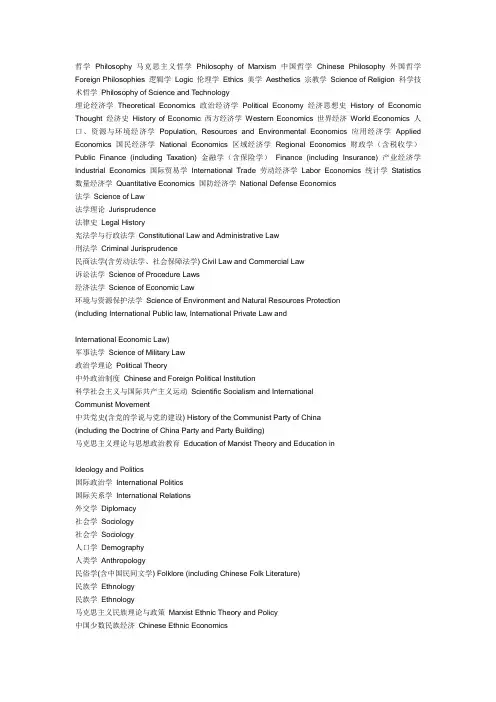
哲学Philosophy 马克思主义哲学Philosophy of Marxism 中国哲学Chinese Philosophy 外国哲学Foreign Philosophies 逻辑学Logic 伦理学Ethics 美学Aesthetics 宗教学Science of Religion 科学技术哲学Philosophy of Science and Technology理论经济学Theoretical Economics 政治经济学Political Economy 经济思想史History of Economic Thought 经济史History of Economic 西方经济学Western Economics 世界经济World Economics 人口、资源与环境经济学Population, Resources and Environmental Economics 应用经济学Applied Economics 国民经济学National Economics 区域经济学Regional Economics 财政学(含税收学)Public Finance (including Taxation) 金融学(含保险学)Finance (including Insurance) 产业经济学Industrial Economics 国际贸易学International Trade 劳动经济学Labor Economics 统计学Statistics 数量经济学Quantitative Economics 国防经济学National Defense Economics法学Science of Law法学理论Jurisprudence法律史Legal History宪法学与行政法学Constitutional Law and Administrative Law刑法学Criminal Jurisprudence民商法学(含劳动法学、社会保障法学) Civil Law and Commercial Law诉讼法学Science of Procedure Laws经济法学Science of Economic Law环境与资源保护法学Science of Environment and Natural Resources Protection(including International Public law, International Private Law andInternational Economic Law)军事法学Science of Military Law政治学理论Political Theory中外政治制度Chinese and Foreign Political Institution科学社会主义与国际共产主义运动Scientific Socialism and InternationalCommunist Movement中共党史(含党的学说与党的建设) History of the Communist Party of China(including the Doctrine of China Party and Party Building)马克思主义理论与思想政治教育Education of Marxist Theory and Education inIdeology and Politics国际政治学International Politics国际关系学International Relations外交学Diplomacy社会学Sociology社会学Sociology人口学Demography人类学Anthropology民俗学(含中国民间文学) Folklore (including Chinese Folk Literature)民族学Ethnology民族学Ethnology马克思主义民族理论与政策Marxist Ethnic Theory and Policy中国少数民族经济Chinese Ethnic Economics中国少数民族史Chinese Ethnic History中国少数民族艺术Chinese Ethnic Art教育学Education Science教育学原理Educational Principle课程与教学论Curriculum and Teaching Methodology教育史History of Education比较教育学Comparative Education学前教育学Pre-school Education高等教育学Higher Education成人教育学Adult Education职业技术教育学Vocational and Technical Education特殊教育学Special Education教育技术学Education Technology基础心理学Basic Psychology 发展与心理学Developmental and Educational Psychology 应用心理学Applied Psychology 体育学Science of Physical Culture and Sports 体育人文社会学Humane and Sociological Science of Sports 运动人体科学Human Movement Science 体育教育训练学Theory of Sports Pedagogy and Training 民族传统体育学Science of Ethnic Traditional Sports中国语言文学Chinese Literature文艺学Theory of Literature and Art语言学及应用语言学Linguistics and Applied Linguistics汉语言文字学Chinese Philology中国古典文献学Study of Chinese Classical Text中国古代文学Ancient Chinese Literature中国现当代文学Modern and Contemporary Chinese Literature中国少数民族语言文学Chinese Ethnic Language andLiterature比较文学与世界文学Comparative Literature and World Literature外国语言文学Foreign Languages and Literatures英语语言文学English Language and Literature俄语语言文学Russian Language and Literature法语语言文学French Language and Literature德语语言文学German Language and Literature日语语言文学Japanese Language and Literature印度语言文学Indian Language and Literature西班牙语语言文学Spanish Language and Literature阿拉伯语语言文学Arabic Language and Literature欧洲语言文学European Language and Literature亚非语言文学Asian-African Language and Literature外国语言学及应用语言学Linguistics and Applied Linguistics inForeign Languages新闻传播学Journalism and Communication 新闻学Journalism 传播学Communication 艺术学Art 艺术学Art Theory 音乐学Music 美术学Fine Arts 设计艺术学Artistic Design 戏剧戏曲学Theater and Chinese Traditional Opera 电影学Film 广播电视艺术学Radio and television Art 舞蹈学Dance 历史学History 历史学History 史学理论及史学史Historical Theories and History of Historical Science 考古学及博物馆学Archaeology and Museology 历史地理学Historical Geography 历史文献学(含敦煌学、古文字学) Studies of Historical Literature (including Paleography and Studies of Dunhuang) 专门史History of Particular Subjects 中国古代史Ancient Chinese History 中国近现代史Modern and Contemporary Chinese History 世界史World History 理学Natural Science基础数学Fundamental Mathematics计算数学Computational Mathematics概率论与数理统计Probability and Mathematical Statistics应用数学Applied Mathematics运筹学与控制论Operational Research and Cybernetics理论物理Theoretical Physics粒子物理与原子核物理Particle Physics and Nuclear Physics原子与分子物理Atomic and Molecular Physics等离子体物理Plasma Physics凝聚态物理Condensed Matter Physics声学Acoustics光学Optics无线电物理Radio Physics无机化学Inorganic Chemistry 分析化学Analytical Chemistry 有机化学Organic Chemistry 物理化学(含化学物理)Physical Chemistry (including Chemical Physics) 高分子化学与物理Chemistry and Physics of Polymers天文学Astronomy 天体物理Astrophysics 天体测量与天体力学Astrometry and Celestial Mechanics 地理学Geography 自然地理学Physical Geography 人文地理学Human Geography 地图学与地理信息系统Cartography and Geography Information System 大气科学Atmospheric Sciences 气象学Meteorology 大气物理学与大气环境Atmospheric Physics and Atmospheric Environment 海洋科学Marine Sciences 物理海洋学Physical Oceanography 海洋化学Marine Chemistry 海洋生理学Marine Biology 海洋地质学Marine Geology 地球物理学Geophysics 固体地球物理学Solid Earth Physics 空间物理学Space Physics矿物学、岩石学、矿床学Mineralogy, Petrology, Mineral Deposit Geology 地球化学Geochemistry 古生物学与地层学(含古人类学)Paleontology and Stratigraphy (including Paleoanthropology) 构造地质学Structural Geology 第四纪地质学Quaternary Geology生物学Biology 植物学Botany 动物学Zoology 生理学Physiology 水生生物学Hydrobiology 微生物学Microbiology 神经生物学Neurobiology 遗传学Genetics 发育生物学Developmental Biology 细胞生物学Cell Biology 生物化学与分子生物学Biochemistry and Molecular Biology 生物物理学Biophysics 生态学Ecology 系统科学Systems Science 系统理论Systems Theory 系统分析与集成Systems Analysis and Integration 科学技术史History of Science and Technology力学Mechanics 一般力学与力学基础General and Fundamental Mechanics 固体力学Solid Mechanics 流体力学Fluid Mechanics 工程力学Engineering Mechanics 机械工程Mechanical Engineering 机械制造及其自动化Mechanical Manufacture and Automation 机械电子工程Mechatronic Engineering 机械设计与理论Mechanical Design and Theory 车辆工程Vehicle Engineering 光学工程Optical Engineering 仪器科学与技术Instrument Science and Technology 精密仪器及机械Precision Instrument and Machinery 测试计量技术及仪器Measuring and Testing Technologies and Instruments 材料科学与工程Materials Science and Engineering 材料物理与化学Materials Physics and Chemistry 材料学Materialogy 材料加工工程Materials Processing Engineering 冶金工程Metallurgical Engineering 冶金物理化学Physical Chemistry of Metallurgy 钢铁冶金Ferrous Metallurgy 有色金属冶金Non-ferrous Metallurgy 动力工程及工程热物理Power Engineering and Engineering Thermophysics 工程热物理Engineering Thermophysics 热能工程Thermal Power Engineering 动力机械及工程Power Machinery and Engineering 流体机械及工程Fluid Machinery and Engineering 制冷及低温工程Refrigeration and Cryogenic Engineering 化工过程机械Chemical Process Equipment 电气工程Electrical Engineering 电机与电器Electric Machines and Electric Apparatus 电力系统及其自动化Power System and its Automation 高电压与绝缘技术High Voltage and Insulation Technology 电力电子与电力传动Power Electronics and Power Drives 电工理论与新技术Theory and New Technology of Electrical Engineering 电子科学与技术Electronics Science and Technology 物理电子学Physical Electronics 电路与系统Circuits and Systems 微电子学与固体电子学Microelectronics and Solid State Electronics 电磁场与微波技术Electromagnetic Field and Microwave Technology 信息与通信工程Information and Communication Engineering 通信与信息系统Communication and Information Systems 信号与信息处理Signal and Information Processing 控制科学与工程Control Science and Engineering 控制理论与控制工程Control Theory and Control Engineering 检测技术与自动化装置Detection Technology and Automatic Equipment 系统工程Systems Engineering 模式识别与智能系统Pattern Recognition and Intelligent Systems 导航、制导与控制Navigation, Guidance and Control 计算机科学与技术Computer Science and Technology 计算机软件与理论Computer Software and Theory 计算机系统结构Computer Systems Organization 计算机应用技术Computer Applied Technology 建筑学Architecture 建筑历史与理论Architectural History and Theory 建筑设计及其理论Architectural Design and Theory 城市规划与设计(含风景园林规划与设计)Urban Planning and Design (including Landscape Planning and Design) 建筑技术科学Building Technology Science 土木工程Civil Engineering 岩土工程Geotechnical Engineering 结构工程Structural Engineering 市政工程Municipal Engineering 供热、供燃气、通风及空调工程Heating, Gas Supply, Ventilating and Air Conditioning Engineering 防灾减灾工程及防护工程Disaster Prevention and Reduction Engineering and Protective Engineering 桥梁与隧道工程Bridge and Tunnel Engineering 水利工程Hydraulic Engineering 水文学及水资源Hydrology and Water Resources 水力学及河流动力学Hydraulics and River Dynamics 水工结构工程Hydraulic Structure Engineering 水利水电工程Hydraulic and Hydro-Power Engineering 港口、海岸及近海工程Harbor, Coastal and Offshore Engineering 测绘科学与技术Surveying and Mapping 大地测量学与测量工程Geodesy and Survey Engineering 摄影测量与遥感Photogrammetry and Remote Sensing 地图制图学与地理信息工程Cartography and Geographic Information Engineering 化学工程与技术Chemical Engineering and Technology 化学工程Chemical Engineering 化学工艺Chemical Technology 生物化工Biochemical Engineering 应用化学Applied Chemistry 工业催化Industrial Catalysis 地质资源与地质工程Geological Resources and Geological Engineering 矿产普查与勘探Mineral Resource Prospecting and Exploration 地球探测与信息技术Geodetection and Information Technology 地质工程Geological Engineering 矿业工程Mineral Engineering 采矿工程Mining Engineering 矿物加工工程Mineral Processing Engineering 安全技术及工程Safety Technology and Engineering 石油与天然气工程Oil and Natural Gas Engineering 油气井工程Oil-Gas Well Engineering 油气田开发工程Oil-Gas Field Development Engineering 油气储运工程Oil-Gas Storage and Transportation Engineering 纺织科学与工程Textile Science and Engineering 纺织工程Textile Engineering 纺织材料与纺织品设计Textile Material and Textiles Design 纺织化学与染整工程Textile Chemistry and Dyeing and Finishing Engineering 服装设计与工程Clothing Design and Engineering 轻工技术与工程The Light Industry Technology and Engineering 制浆造纸工程Pulp and Paper Engineering 制糖工程Sugar Engineering 发酵工程Fermentation Engineering 皮革化学与工程Leather Chemistry and Engineering 交通运输工程Communication and Transportation Engineering 道路与铁道工程Highway and Railway Engineering 交通信息工程及控制Traffic Information Engineering & Control 交通运输规划与管理TransportationPlanning and Management 载运工具运用工程Vehicle Operation Engineering 船舶与海洋工程Naval Architecture and Ocean Engineering 船舶与海洋结构物设计制造Design and Construction of Naval Architecture and Ocean Structure 轮机工程Marine Engine Engineering 水声工程Underwater Acoustics Engineering 航空宇航科学与技术Aeronautical and Astronautical Science and Technology 飞行器设计Flight Vehicle Design 航空宇航推进理论与工程Aerospace Propulsion Theory and Engineering 航空宇航器制造工程Manufacturing Engineering of Aerospace Vehicle 人机与环境工程Man-Machine and Environmental Engineering 兵器科学与技术Armament Science and Technology 武器系统与运用工程Weapon Systems and Utilization Engineering 兵器发射理论与技术Armament Launch Theory and Technology 火炮、自动武器与弹药工程Artillery, Automatic Gun and Ammunition Engineering 军事化学与烟火技术Military Chemistry and Pyrotechnics 核科学与技术Nuclear Science and Technology 核能科学与工程Nuclear Energy Science and Engineering 核燃料循环与材料Nuclear Fuel Cycle and Materials 核技术及应用Nuclear Technology and Applications 辐射防护及环境保护Radiation and Environmental Protection 农业工程Agricultural Engineering 农业机械化工程Agricultural Mechanization Engineering 农业水土工程Agricultural Water-Soil Engineering 农业生物环境与能源工程Agricultural Biological Environmental and Energy Engineering 农业电气化与自动化Agricultural Electrification and Automation 林业工程Forestry Engineering 森林工程Forest Engineering 木材科学与技术Wood Science and Technology 林产化学加工工程Chemical Processing Engineering of Forest Products 环境科学与工程Environmental Science and Engineering 环境科学Environmental Science 环境工程Environmental Engineering 生物医学工程Biomedical Engineering 食品科学与工程Food Science and Engineering 食品科学Food Science 粮食、油脂及植物蛋白工程Cereals, Oils and Vegetable Protein Engineering学士Bachelor of Arts B.A. 文学士Bachelor of Arts in Education B.A.Ed., B.A.E. 教育学文学士Bachelor of Arts in Computer Science B.A.CS 计算机文学士Bachelor of Arts in Music B.A.Mus,B.Mus 音乐艺术学士Bachelor of Arts in Social Work B.A.S.W 社会工作学文学士Bachelor of Engineering B.Eng., B.E 工学士Bachelor of Engineering in Social Science B.Eng.Soc 社会工程学士Bachelor of Engineering in Management B.Eng.Mgt 管理工程学士Bachelor of Environmental Science/Studies B.E.Sc., B.E.S 环境科学学士Bachelor of Science B.S 理学士Bachelor of Science in Business B.S.B., B.S.Bus 商学理学士Bachelor of Science in Business Administration B.S.B.A 工商管理学理学士Bachelor of Science in Education B.S.Ed., B.S.E 教育学理学士Bachelor of Science in Engineering B.S.Eng., B.S.E 工程学理学士Bachelor of Science in Forestry B.S.cF 森林理学士Bachelor of Science in Medicine B.S.Med 医学理学士Bachelor of Science in Medical Technology B.S.M.T., B.S.Med.Tech 医技学理学士Bachelor of Science in Nursing B.S.N., B.S.Nurs 护理学理学士Bachelor of Science in Nutrition B.SN 营养学理学士Bachelor of Science in Social Work B.S.S.W 社会工作学理学士Bachelor of Science in Technology B.S.T 科技学理学士Bachelor of Computer Science B.CS 计算机理学士Bachelor of Computer Special Science B.CSS 计算机特殊理学士Bachelor of Architecture B. Arch. 建筑学士Bachelor of Administration B.Admin. 管理学士Bachelor of Business Administration B.B.A. 工商管理学士Bachelor of Education B.Ed., B.E 教育学士Bachelor of Fine Arts B.F.A. 艺术学士Bachelor of General Studies B.G.S 通识学士Bachelor of Liberal Studies B.L.S 文理学学士Bachelor of Health Science BHSc 健康科学学士Bachelor of Music B.M., B.Mus 音乐学士Bachelor of Music Education B.M.Ed., B.M.E 音乐教育学士Bachelor of Nursing B.N 护理学士Bachelor of Professional Studies B.P.S 专业进修学士Bachelor of Law LL.B 法学士Bachelor of Commerce ., . 商学士Bachelor in Social Work B.S.W 社会工作学士Bachelor of Technology B.T 科技学士Bachelor of Kinesiology B.K., B.Kin 运动机能学学士Bachelor of Landscape Architecture 景观建筑学士Bachelor of Nursing B.N 护理学士Bachelor of Physical B.PE 体育学士Bachelor of Resource Management B.RM 资源管理学士Bachelor of Theology B.Th 神学士硕士Master of Arts M.A 文学硕士Master of Accounting M.Acc 会计学硕士Master of Arts in Education M.A.Ed 教育学文学硕士Master of Architecture M.Arch 建筑学硕士Master of Arts in Teaching M.A.T 教育文学硕士Master of Business Administration M.B.A 工商管理学硕士Master of Civil Engineering M.C.E 土木工程学硕士Master of Chemical Engineering M.Ch.E., M.C.E 化学工程学硕士Master of Criminal Justice M.C.J 刑事学硕士Master of Divinity M.Div 神学学硕士Master of Engineering M.E 工程学硕士Master of Education M.Ed 教育学硕士Master of Economics M.Ec 经济学硕士Master of Electrical Engineering M.E.E 电机工程学硕士Master of Fine Arts M.F.A 艺术硕士Master of Law M.L 法学硕士Master of Library Science M.L.S 图书馆学硕士Master of Music M.M., M.Mus 音乐硕士Master of Music Education M.M.E., M.M.Ed 音乐教育学硕士Master of Nursing M.N 护理学硕士Master of Public Administration M.P.A 公共行政学硕士Master of Psychology M.Psy 心理学硕士Master of Science M.S 理学硕士Master of Science in Criminal Justice M.S.C.J 刑事理学硕士Master of Science in Education M.S.E., M.S.Ed 教育理学硕士Master of Science in Electrical Engineering M.S.E.E 电机工程理学硕士Master of Science in Library Science M.S.L.S 图书馆理学硕士Master of Science in Medical Technology M.S.M.T 医技理学硕士Master of Science in Nursing M.S.N 护理理学硕士Master of Science in Social Work M.S.S.W 社会工作理学硕士Master of Social Work M.S.W 社会工作学硕士博士Doctor of Arts D.A 文学博士Doctor of Dental Science D.D.S 牙科博士Doctor of Science D.Sc.; Sc.D 科学博士Doctor of Engineering D.E 工程博士Doctor of Education D.Ed 教育学博士Doctor of Musical Arts D.M.A 音乐艺术博士Doctor of Osteopathy D.O 骨科博士Doctor of Social Science D.S.S 社会科学博士Doctor of Veterinary Medicine D.V.M 兽医学博士Doctor of Jurisprudence J.D 法理学博士Doctor of Judicial Science J.S.D 司法学博士Doctor of Business Administration D.B.A 工商管理博士Doctor of Accountancy D.Acc 会计学博士常用词4=FOR 到永远=FOREVER2=TO RTN=RETURN(送回)BT=BLOOD TYPE(血型) PLS=PLEASE(请)BD=BIRTHDAY(生日) REWARD=酬谢REWARD 4 RETURN=送回有酬谢ALLRG=过敏军事术语USMC=海军陆战队NAVY=海军AF=AIR FORCE(空军) ARMY=陆军宗教类C=CHRISTIANISM(基督教) J=JUDAISM(犹太教)C=CATHOLICISM(天主教) B=BUDDHISM(佛教)I=ISLAM(伊斯兰教)NR=NO REFERENCE(没有宗教信仰)星座水瓶座:AQUARIUS(1月21日- 2月19日)双鱼座:PISCES(2月20日- 3月20日)白羊座:ARIES (3月21日- 4月20日)金牛座:TAURUS(4月21日- 5月21日)双子座:GEMINI(5月22日- 6月21日)巨蟹座:CANCER(6月22日- 7月23日)狮子座:LEO(7月24日- 8月23日)处女座:VIRGO(8月24日- 9月23日)天秤座:LIBRA (9月24日- 10月23日)天蝎座:SCORPIUS(10月24日- 11月22日)人马座:SAGITTARIUS(11月23日- 12月21日)山羊座:CAPRICORNUS (12月22日- 1月20日)1. 国际性或全美性:UNESCO (United Nations Educational, Scientific and Cultural organization)联合国教育科学文化组织(也叫国际文教组织)例如:(The)UNESCO has made some contributions to the world.(UNESCO 对世界做出一些贡献)NATO(North Atlantic Treaty organization)北大西洋公约组织。
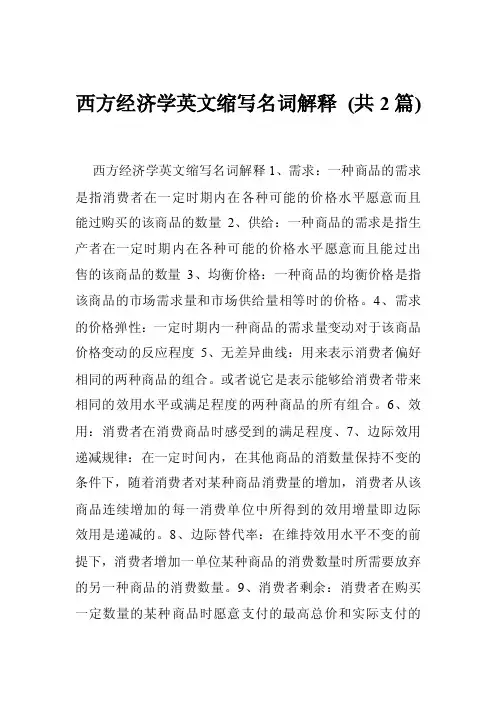
西方经济学英文缩写名词解释(共2篇)西方经济学英文缩写名词解释1、需求:一种商品的需求是指消费者在一定时期内在各种可能的价格水平愿意而且能过购买的该商品的数量2、供给:一种商品的需求是指生产者在一定时期内在各种可能的价格水平愿意而且能过出售的该商品的数量3、均衡价格:一种商品的均衡价格是指该商品的市场需求量和市场供给量相等时的价格。
4、需求的价格弹性:一定时期内一种商品的需求量变动对于该商品价格变动的反应程度5、无差异曲线:用来表示消费者偏好相同的两种商品的组合。
或者说它是表示能够给消费者带来相同的效用水平或满足程度的两种商品的所有组合。
6、效用:消费者在消费商品时感受到的满足程度、7、边际效用递减规律:在一定时间内,在其他商品的消数量保持不变的条件下,随着消费者对某种商品消费量的增加,消费者从该商品连续增加的每一消费单位中所得到的效用增量即边际效用是递减的。
8、边际替代率:在维持效用水平不变的前提下,消费者增加一单位某种商品的消费数量时所需要放弃的另一种商品的消费数量。
9、消费者剩余:消费者在购买一定数量的某种商品时愿意支付的最高总价和实际支付的总价格之间的差额。
10、生产函数:表示在一定时期内,在技术水平不变的情况下,生产中所使用的生产要素的数量与所能生产的最大产量之间的关系。
11、机会成本:一般的,生产一单位的某种商品的机会成本是指生产者所放弃的使用相同的生产要素在其他生产用途中所能得到的最高收入。
12、边际技术替代率:在维持产量水平不变的条件下,增加一单位某种生产要素的投入量是所减少的另一种要素的投入量。
13、恩格尔定律:随收入提高,食物支出在全部支出中所占比例减小14、规模报酬:是指在其他条件不变的情况下,企业内部各种生产要素按相同比例变化所带来的产量变化。
15、国内生产总值:是指在经济社会在一定时期内运用生产要素所生产的全部最终产品(物品和劳务)的市场价值。
16、IS曲线:一条反映利率和收入之间关系的曲线。

西方经济学名词解释551、Monetary union 货币联盟若干国家采用同一种通用货币作为会计单位和交换媒介的一种制度安排。
欧洲货币联盟计划1999年采用欧元作为通用货币。
552、Money 货币支付手段或交换媒介。
关于货币的构成,请参见货币供应(money supply)。
553、Money demand schedule 货币需求表体现的是货币持有需求和利率水平之间的对应关系。
当利率上升时,债券和其他有价证券的吸引力增大,货币的需求量会降低。
见货币需求(demand for money)。
554、Money funds 货币资金灵活性很强的短期金融工具的简称,其利率是不固定的。
主要形式包括货币市场互助基金和商业银行货币市场活期存款帐户。
555、Money market 货币市场金融术语,指一套处理短期信贷工具(如国库券和商业票据)买卖活动的制度安排。
556、Money supply 货币供应狭义的货币供应(M1)包括铸币、纸币、所有的活期存款或支票存款,称为狭义货币或交易货币。
广义的货币供应(M2)包括M1的所有项目,再加上某些灵活性资产或若干准货币(near -monies),如储蓄存款、货币市场基金和其他类似项目。
557、Money-supply effect 货币供给效应名义货币供应量不变时,价格上升与相应的货币紧缩、总支出下降这二者之间的关系。
558、Money-supply multiplier 货币供给乘数货币供给(或存款)增长与银行准备金增长的比率。
一般说来,货币供给乘数等于法定准备金比率的倒数。
例如,法定准备金比率是0.125,那么货币供给乘数就是8。
559、Money,velocity of 货币周转率见货币周转率(velocity of money)。
560、Monopolistic competition 垄断竞争一种市场结构,其中有许多卖者,他们所提供的产品接近、但不可以完全替代。
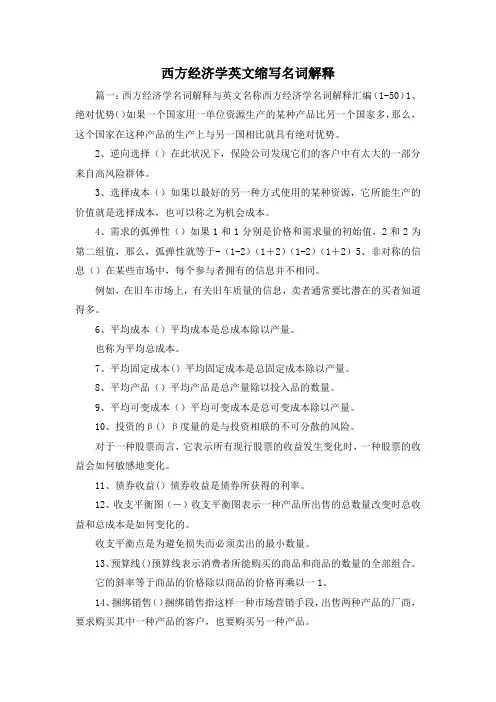
西方经济学英文缩写名词解释篇一:西方经济学名词解释与英文名称西方经济学名词解释汇编(1-50)1、绝对优势()如果一个国家用一单位资源生产的某种产品比另一个国家多,那么,这个国家在这种产品的生产上与另一国相比就具有绝对优势。
2、逆向选择()在此状况下,保险公司发现它们的客户中有太大的一部分来自高风险群体。
3、选择成本()如果以最好的另一种方式使用的某种资源,它所能生产的价值就是选择成本,也可以称之为机会成本。
4、需求的弧弹性()如果1和1分别是价格和需求量的初始值,2和2为第二组值,那么,弧弹性就等于-(1-2)(1+2)(1-2)(1+2)5、非对称的信息()在某些市场中,每个参与者拥有的信息并不相同。
例如,在旧车市场上,有关旧车质量的信息,卖者通常要比潜在的买者知道得多。
6、平均成本()平均成本是总成本除以产量。
也称为平均总成本。
7、平均固定成本()平均固定成本是总固定成本除以产量。
8、平均产品()平均产品是总产量除以投入品的数量。
9、平均可变成本()平均可变成本是总可变成本除以产量。
10、投资的β()β度量的是与投资相联的不可分散的风险。
对于一种股票而言,它表示所有现行股票的收益发生变化时,一种股票的收益会如何敏感地变化。
11、债券收益()债券收益是债券所获得的利率。
12、收支平衡图(-)收支平衡图表示一种产品所出售的总数量改变时总收益和总成本是如何变化的。
收支平衡点是为避免损失而必须卖出的最小数量。
13、预算线()预算线表示消费者所能购买的商品和商品的数量的全部组合。
它的斜率等于商品的价格除以商品的价格再乘以一1。
14、捆绑销售()捆绑销售指这样一种市场营销手段,出售两种产品的厂商,要求购买其中一种产品的客户,也要购买另一种产品。
15、资本()资本是指用于生产、销售及商品和服务分配的设备、厂房、存货、原材料和其他非人力生产资源。
16、资本收益()资本收益是指人们卖出股票(或其他资产)时所获得的超过原来为它支付的那一部分。
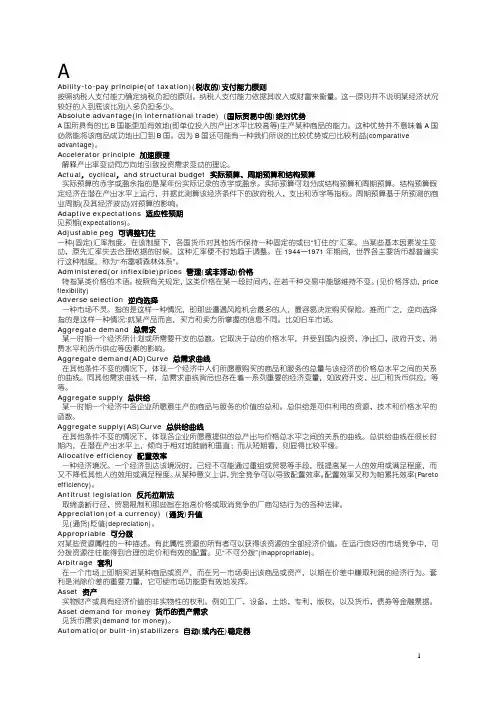
AAbility-to-pay principle(of taxation)(税收的)支付能力原则按照纳税人支付能力确定纳税负担的原则。
纳税人支付能力依据其收入或财富来衡量。
这一原则并不说明某经济状况较好的人到底该比别人多负担多少。
Absolute advantage(in international trade) (国际贸易中的)绝对优势A国所具有的比B国能更加有效地(即单位投入的产出水平比较高等)生产某种商品的能力。
这种优势并不意味着A国必然能将该商品成功地出口到B国。
因为B国还可能有一种我们所说的比较优势或曰比较利益(comparative advantage)。
Accelerator principle 加速原理解释产出率变动同方向地引致投资需求变动的理论。
Actual,cyclical,and structural budget 实际预算、周期预算和结构预算实际预算的赤字或盈余指的是某年份实际记录的赤字或盈余。
实际预算可划分成结构预算和周期预算。
结构预算假定经济在潜在产出水平上运行,并据此测算该经济条件下的政府税人、支出和赤字等指标。
周期预算基于所预测的商业周期(及其经济波动)对预算的影响。
Adaptive expectations 适应性预期见预期(expectations)。
Adjustable peg 可调整钉住一种(固定)汇率制度。
在该制度下,各国货币对其他货币保持一种固定的或曰“钉住的”汇率。
当某些基本因素发生变动、原先汇率失去合理依据的时候,这种汇率便不时地趋于调整。
在1944—1971年期间,世界各主要货币都普遍实行这种制度,称为“布雷顿森林体系”。
Administered(or inflexible)prices 管理(或非浮动)价格特指某类价格的术语。
按照有关规定,这类价格在某一段时间内、在若干种交易中能够维持不变。
(见价格浮动,price flexibility)Adverse selection 逆向选择一种市场不灵。
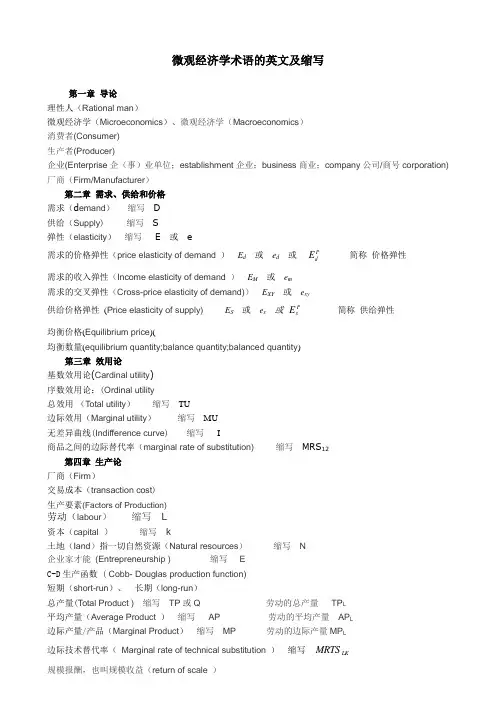
微观经济学术语的英文及缩写第一章导论理性人(Rational man)微观经济学(Microeconomics)、微观经济学(Macroeconomics)消费者(Consumer)生产者(Producer)企业(Enterprise企(事)业单位;establishment企业;business商业;company公司/商号corporation) 厂商(Firm/Manufacturer)第二章需求、供给和价格需求(d emand)缩写D供给(Supply) 缩写S弹性(elasticity)缩写 E 或 eE简称价格弹性需求的价格弹性(price elasticity of demand )E d或e d 或Pd需求的收入弹性(Income elasticity of demand )E M或e m需求的交叉弹性(Cross-price elasticity of demand))E XY或e xy供给价格弹性(Price elasticity of supply)E S或e s 或P s E简称供给弹性均衡价格(Equilibrium price)(均衡数量(equilibrium quantity;balance quantity;balanced quantity)第三章效用论基数效用论(Cardinal utility)序数效用论:(Ordinal utility总效用(T otal utility)缩写TU边际效用(Marginal utility)缩写MU无差异曲线(Indifference curve) 缩写I商品之间的边际替代率(marginal rate of substitution) 缩写MRS12第四章生产论厂商(Firm)交易成本(transaction cost)生产要素(Factors of Production)劳动(labour)缩写L资本(capital )缩写k土地(Iand)指一切自然资源(Natural resources)缩写N企业家才能(Entrepreneurship ) 缩写 EC-D生产函数 ( Cobb- Douglas production function)短期(short-run)、长期(long-run)总产量(Total Product ) 缩写TP或Q 劳动的总产量TP L平均产量(Average Product )缩写AP 劳动的平均产量AP L边际产量/产品(Marginal Product)缩写MP 劳动的边际产量MP L分increasing returns of scale、constant returns of scale、decreasing returns of scale等成本线(Isocost line)等产量线(Isoquant line)第五章成本论成本(cost) 缩写 C费用(expense)机会成本(Opportunity cost)显成本(Explicit cost)隐成本(Implicit cost)正常利润(Normal profit)超额利润(Excess profit)或叫经济利润(Econormic profit)经常用π表示、利润最大化(profit maximization)利润最大化原则(principle of profit maximization)短期总成本(Short-run total cost)缩写STC 或TC总固定成本(T otal fixed cost)缩写TFC 或FC总变动成本(T otal variable cos t)缩写TVC 或VC平均固定成本(Average fixed cost ) 缩写AFC平均可变成本(Average variable cost ) AVC短期平均成本(Short-run average cost) SAC 或AC短期边际成本(Short-run marginal cos t) SMC 或MC长期总成本(Long-run total cost)LTC 或TC长期平均成本(Long-run average cos t) LAC 或AC长期边际成本(Long-run marginal cost) LMC 或MC规模经济(Economies of scale)、规模不经济(Diseconomies of scale)外在经济(The external economy)、外在不经济(External diseconomy)收益(Revenue)R总收益( total revenue;gross earnings;gross income) TR平均收益(average revenue)AR边际收益(marginal income )MR第六章完全竞争市场市场结构(Market structure)完全竞争市场(perfect competition market)长期供给线(Long-run supply curve) LS消费者剩余(Consumer’s surplus)CS生产者剩余(Producer’s surplus) PS (Producer surplus)看不见手的原理(Invisible hand theorem)第七章不完全竞争市场(Imperfect competition market)完全垄断市场(Complete monopoly market (Monopoly):卖方垄断(Monopoly)/买方(Monopsony)垄断竞争(Monopolistic Competition )/垄断竞争市场(Monopolistic Competition Market)寡头垄断(Oligopsony)/寡头垄断市场(Oligopsony market)价格歧视(Price discrimination)一级价格歧视(First-degree price discrimination)二级价格歧视(Second- degree price discrimination)三级价格歧视(Third-degree price discrimination)博弈论(Game theory)纳什均衡(Nash equilibrium)囚犯困境(prisoners’ dilemma)第八章生产要素边际收益产品(Marginal Revenue Product)MRP边际产品价值(Value of marginal product) VMP边际要素成本(Marginal Factor Cost)MFC工资( Wage) w 最低工资minimum wage实际工资(Real wages)\名义工资(Normal wages)地租/ 租金(rent) R利息(Interest) 、利率(Interest rate)缩写r实际利率(Real Interest rate)、名义利率(Normal Interest rate)洛伦慈曲线(Lorenz curve)基尼系数( Gink coefficient ) 缩写G第十章一般均衡和福利经济学(这一章不用看)埃奇沃思盒(Edgeworth’s Box)帕累托最优(Pareto-optimality) 帕累托最优状态帕累托效率(Pareto efficiency)、帕累托改进(Pareto improvement)福利经济学(welfare economics)福利经济学第一定律(First Fundamental Theorem of Welfare Economics)福利经济学第二定律(Second Fundamental Theorem of Welfare Economics)边际生产转换率(the marginal rateof product transformation)MRTS XY边际转换率(marginal rate of transformation)MTS XY =MRTS XY =ΔY/ΔX第十一章微观经济政策市场失灵(market failure)外部影响(External effects) 、外部效应Externalities外部经济(external economies )、外部不经济(external diseconomies)私人成本(private cost;personal cost)、社会成本(social cost)科斯定理(Kos's theorem)the Coase theorem (科斯定理)共有财产(community of goods;joint property)私人物品(private goodst)、公共物品(Public goods)搭便车(Free ride / Free-Riding)或thumb a lift [or ride];hitchhike;pick up; hitch a ride)搭便车者pick up a hitch-hiker竞争性(Competitive)、非竞争性non-competitive/ non-rival排他性(Exclusive)、非排他性non-exclusive /nonexcludable公共选择(Public choice)完全信息(C omplete information)、不完全信息(Imperfect information;incomplete information)不对称信息(Asymmetric Information)逆向选择(Adverse Selection)道德风险(Moral hazard)次品市场(lemon market) :柠檬市场(lemon market),lemon market problem也叫asymmetric informationproblem (信息不对称问题)次品(substandard [shoddy] products;substandard)。
西方经济学英文缩写名词解释篇一:西方经济学名词解释与英文名称西方经济学名词解释汇编(1-50)1、绝对优势(Absolute advantage)如果一个国家用一单位资源生产的某种产品比另一个国家多,那么,这个国家在这种产品的生产上与另一国相比就具有绝对优势。
2、逆向选择(Adverse choice)在此状况下,保险公司发现它们的客户中有太大的一部分来自高风险群体。
3、选择成本(Alternative cost)如果以最好的另一种方式使用的某种资源,它所能生产的价值就是选择成本,也可以称之为机会成本。
4、需求的弧弹性( Arc elasticity of demand)如果P1和Q1分别是价格和需求量的初始值,P2 和Q2 为第二组值,那么,弧弹性就等于 -(Q1-Q2)(P1+P2)/(P1-P2)(Q1+Q2)5、非对称的信息(Asymmetric information)在某些市场中,每个参与者拥有的信息并不相同。
例如,在旧车市场上,有关旧车质量的信息,卖者通常要比潜在的买者知道得多。
6、平均成本(Average cost)平均成本是总成本除以产量。
也称为平均总成本。
7、平均固定成本( Average fixed cost)平均固定成本是总固定成本除以产量。
8、平均产品(Average product)平均产品是总产量除以投入品的数量。
9、平均可变成本(Average variable cost)平均可变成本是总可变成本除以产量。
10、投资的β(Beta)β度量的是与投资相联的不可分散的风险。
对于一种股票而言,它表示所有现行股票的收益发生变化时,一种股票的收益会如何敏感地变化。
11、债券收益(Bond yield)债券收益是债券所获得的利率。
12、收支平衡图(Break-even chart)收支平衡图表示一种产品所出售的总数量改变时总收益和总成本是如何变化的。
收支平衡点是为避免损失而必须卖出的最小数量。
西方经济学名词解释551、Monetary union 货币联盟若干国家采用同一种通用货币作为会计单位和交换媒介的一种制度安排。
欧洲货币联盟计划1999年采用欧元作为通用货币。
552、Money 货币支付手段或交换媒介。
关于货币的构成,请参见货币供应( money supply )。
553、Money demand schedule 货币需求表体现的是货币持有需求和利率水平之间的对应关系。
当利率上升时,债券和其他有价证券的吸引力增大,货币的需求量会降低。
见货币需求 ( demand for money )。
554、Money funds 货币资金灵活性很强的短期金融工具的简称,其利率是不固定的。
主要形式包括货币市场互助基金和商业银行货币市场活期存款帐户。
555、Money market 货币市场金融术语,指一套处理短期信贷工具 (如国库券和商业票据)买卖活动的制度安排。
556、Money supply 货币供应狭义的货币供应( M1 )包括铸币、纸币、所有的活期存款或支票存款,称为狭义货币或交易货币。
广义的货币供应(M2 )包括M1 的所有项目,再加上某些灵活性资产或若干准货币(near -monies),如储蓄存款、货币市场基金和其他类似项目。
557、Money -supply effect 货币供给效应名义货币供应量不变时,价格上升与相应的货币紧缩、总支出下降这二者之间的关系。
558、Money -supply multiplier 货币供给乘数货币供给(或存款)增长与银行准备金增长的比率。
一般说来,货币供给乘数等于法定准备金比率的倒数。
例如,法定准备金比率是0.125,那么货币供给乘数就是8。
559、Money ,velocity of 货币周转率见货币周转率(velocity of money )。
560、Monopolistic competition 垄断竞争一种市场结构,其中有许多卖者,他们所提供的产品接近、但不可以完全替代。
常用的经济术语的英文缩写及简要解释经济学术语解释1、什么是CPI、通货膨胀、PPI和GNP缩减指数?消费者物价指数(Consumer Price Index),英文缩写为CPI,是反映与居民生活有关的产品及劳务价格统计出来的物价变动指标,通常作为观察通货膨胀水平的重要指标。
如果消费者物价指数升幅过大,表明通胀已经成为经济不稳定因素,央行会有紧缩货币政策和财政政策的风险,从而造成经济前景不明朗。
因此,该指数过高的升幅往往不被市场欢迎。
例如,在过去12个月,消费者物价指数上升2。
3%,那表示,生活成本比12个月前平均上升2。
3%。
当生活成本提高,你的金钱价值便随之下降。
也就是说,一年前收到的一张100元纸币,今日只可以买到价值97。
70元的货品及服务。
一般说来当CPI>3%的增幅时我们称为Inflation,就是通货膨胀;而当CPI>5%的增幅时,我们把他称为Serious Inflation,就是严重的通货膨胀。
主要价格指数有三个:消费者价格指数CPI(Consumer’s Price Index),生产者价格指数PPI(Producer’s Price Index),GNP缩减指数(GNP Deflator)。
三种价格指数的计算方法基本一样,即各种商品的价格变化程度的加权平均。
不过,每一种价格指数计算中选择的商品篮子不一样。
计算消费者价格指数时,商品篮子中包含的典型市民的消费篮子。
所以,消费者价格指数也被称为生活成本指数。
生产者价格指数计算时,选取的商品篮子中包含的是生产资源。
GNP缩减指数则是一个更具综合性的指数,其计算中选取的商品篮子既包含消费品,也包含生产资源。
可以这样说,CPI是一个同步经济指标,PPI是一个先行经济指标。
一般来说生产者价格指数领先于经济3个月到半年,消费者滞后于经济3个月到半年。
CPI可以显示目前经济状况,而PPI可以显示未来经济状况。
PPI计算的是厂商出售的价格,而CPI计算的是消费者购买的价格。
常见经济名词英⽂缩写1、什么是CPI、通货膨胀、PPI和GNP缩减指数?消费者物价指数(Consumer Price Index),英⽂缩写为CPI,是反映与居民⽣活有关的产品及劳务价格统计出来的物价变动指标,通常作为观察通货膨胀⽔平的重要指标。
如果消费者物价指数升幅过⼤,表明通胀已经成为经济不稳定因素,央⾏会有紧缩货币政策和财政政策的风险,从⽽造成经济前景不明朗。
因此,该指数过⾼的升幅往往不被市场欢迎。
例如,在过去12个⽉,消费者物价指数上升2。
3%,那表⽰,⽣活成本⽐12个⽉前平均上升2。
3%。
当⽣活成本提⾼,你的⾦钱价值便随之下降。
也就是说,⼀年前收到的⼀张100元纸币,今⽇只可以买到价值97。
70元的货品及服务。
⼀般说来当CPI>3%的增幅时我们称为Inflation,就是通货膨胀;⽽当CPI>5%的增幅时,我们把他称为Serious Inflation,就是严重的通货膨胀。
主要价格指数有三个:消费者价格指数CPI(Consumer’s Price Index),⽣产者价格指数PPI(Producer’s Price Index),GNP缩减指数(GNP Deflator)。
三种价格指数的计算⽅法基本⼀样,即各种商品的价格变化程度的加权平均。
不过,每⼀种价格指数计算中选择的商品篮⼦不⼀样。
计算消费者价格指数时,商品篮⼦中包含的典型市民的消费篮⼦。
所以,消费者价格指数也被称为⽣活成本指数。
⽣产者价格指数计算时,选取的商品篮⼦中包含的是⽣产资源。
GNP缩减指数则是⼀个更具综合性的指数,其计算中选取的商品篮⼦既包含消费品,也包含⽣产资源。
可以这样说,CPI是⼀个同步经济指标,PPI是⼀个先⾏经济指标。
⼀般来说⽣产者价格指数领先于经济3个⽉到半年,消费者滞后于经济3个⽉到半年。
CPI可以显⽰⽬前经济状况,⽽PPI可以显⽰未来经济状况。
PPI计算的是⼚商出售的价格,⽽CPI 计算的是消费者购买的价格。
Macroeconomics 宏观经济学The study of the overall aspects and workings of a national economy, such as income, output, and the interrelationship among diverse economic sectors.研究国民收入的各方面。
Microeconomics 微观经济学The study of the operations of the components of a national economy, such as individual firms, households, and consumers.研究经济中单个因素行为的分析。
GDP 国内生产总值(Gross Domestic Product)The total market value of all final goods and services produced within the borders of a nation during a specified period.一国国民在各行业中一年内生产的最终产品和最终服务价值总和。
It is often seen as an indicator of the standard of living in a country.Gross Domestic Product=consumption + investment goods + government purchases + net exportsEconomic Growth 经济增长steady growth in the productive capacity of the economy (and so a growth of national income)Real Economic Growth Rate 实际经济增长率A measure of economic growth from one period to another expressed as a percentage and adjusted for inflation (i.e. expressed in real as opposed to nominal terms). The real economic growth rate is a measure of the rate of change that a nation's gross domestic product (GDP) experiences from one year to another. Gross national product (GNP) can also be used if a nation's economy is heavily dependent on foreign earnings. The real economic growth rate builds onto the economic growth rate by taking into account the effect that inflation has on the economy. The real economic growth rate is a "constant dollar" and therefore a more accurate look at the rate of economic growth because the real rate is not distorted by the effects of extreme inflation or deflation.GDP deflator GDP指数In economics the GDP deflator (implicit price deflator for GDP) is a measure of the change in prices of all new, domestically produced, final goods and services in an economy. GDP stands for gross domestic product the total value of all goods and services produced within that economy during a specified period.Nominal GDP 名义GDPA gross domestic product (GDP) figure that has not been adjusted for inflation.Real GDP 实际GDPThis inflation-adjusted measure that reflects the value of all goods and services produced in a given year, expressed in base-year prices. Often referred to as "constant-price", "inflation-corrected" GDP or "constant dollar GDP". Unlike nominal GDP, real GDP can account for changes in the price level, and provide a more accurate figure.Potential output 潜在产量/潜在GDPIn economics, potential output (also refered to as "natural real gross domestic product") refers to the highest level of real Gross Domestic Product output that can be sustained over the long term.GDP Gap GDP缺口The forfeited output of an country's economy resulting from the failure to create sufficient jobs for all those willing to work. A GDP gap denotes the amount of production that is irretrievably lost. The potential for higher production levels is wasted because there aren't enough jobs supplied.(与书异)Net Exports 净出口The value of a country's total exports minus the value of its total imports. It is used to calculate a country's aggregate expenditures, or GDP, in an open economy. In other words, net exports is the amount by which foreign spending on a home country's goods and services exceeds the home country's spending on foreign goods and services.Recession 经济衰退A significant decline in activity spread across the economy, lasting longer than a few months. It is visible in industrial production, employment, real income, and wholesale-retail trade. The technical indicator of a recession is two consecutive quarters of negative economic growth as measured by a country's GDP.Notes:Recession is a normal (albeit unpleasant) part of the business cycle. A recession generally lasts from six to eighteen months. Interest rates usually fall in recessionary times to stimulate the economy by offering cheap rates at which to borrowDepression 经济萧条A severe and prolonged recession characterized by inefficient economic productivity, high unemployment, and falling price levels. In times of depression, consumer's confidence and investments decrease, causing the economy to shutdown.Value Added 附加值The enhancement a company gives its product or service before offering the product to customers. This can either increase the products price or value.(与书异)Gross National Product – GNP 国民生产总值An economic statistic that includes GDP, plus any income earned by residents from overseas investments, minus income earned within the domestic economy by overseas residents. GNP is a measure of a country's economic performance, or what its citizens produced (i.e. goods and services) and whether they produced these items within its borders.Disposable Income 可支配收入The amount of after-tax income that is available to divide between spending and personal savings. This also known as your take home pay.Unemployment Rate 失业率The percentage of the total labor force that is unemployed but actively seeking employment and willing to work.Labor force 劳动力the group of people who have a potential for being employed.Frictional Unemployment 摩擦性事业Unemployment that is always present in the economy, resulting from temporary transitions made by workers and employers or from workers and employers having inconsistent or incomplete information.Structural Unemployment 结构性失业Unemployment resulting from changes in the basic composition of the economy. These changes simultaneously open new positions for trained workers.Cyclical Unemployment 周期性失业Unemployment resulting from changes in the business cycle.Natural Unemployment 自然失业率(与书异)The lowest rate of unemployment that an economy can sustain over the long run. Keynesians believe that a government can lower the rate of unemployment (i.e. employ more people) if it were willing to accept a higher level of inflation (the idea behind the Phillips Curve). However, critics of this say that the effect is temporary and that unemployment would bounce back up but inflation would stay high. Thus, the natural, or equilibrium, rate is the lowest level of unemployment at which inflation remains stable. Also known as the "non-accelerating inflation rate of unemployment" (NAIRU).Notes:When the economy is said to be at full employment, it is at its natural rate of unemployment. Economists debate how the natural rate might change. For example, some economists think that increasing labor-market flexibility will reduce the natural rate. Other economists dispute the existence of a natural rate altogether!Frictional unemployment — This reflects the fact that it takes time for people to find and settle into new jobs. If 12 individuals each take one month before they start a new job, the aggregate unemployment statistics will record this as a single unemployed worker. Technological change often reduces frictional unemployment, for example: the internet made job searches cheaper and more comprehensive.Structural unemployment —This reflects a mismatch between the skills and other attributes of the labour force and those demanded by employers. If 4 workers each take six months off to re-train before they start a new job, the aggregate unemployment statistics will record this as two unemployed workers. Technological change often increases structural unemployment, for example: technological change might require workers to re-train.Natural rate of unemployment —This is the summation of frictional and structural unemployment. It is the lowest rate of unemployment that a stable economy can expect to achieve, seeing as some frictional and structural unemployment is inevitable. Economists do not agree on the natural rate, with estimates ranging from 1% to 5%, or on its meaning — some associate it with "non-accelerating inflation.The estimated rate varies from country to country and from time to time.Demand deficient unemployment — In Keynesian economics, any level of unemployment beyond the natural rate is most likelydue to insufficient demand in the overall economy. During a recession, aggregate expenditure is deficient causing the underutilization of inputs (including labour). Aggregate expenditure (AE) can be increased, according to Keynes, by increasing consumption spending (C), increasing investment spending (I), increasing government spending (G), or increasing the net of exports minus imports (X−M).{AE = C + I + G + (X−M)}Okun's Law 奥昆法则A relationship between an economy's GDP gap and the actual unemployment rate. The relationship is represented by a ratio of 1 to 2.5. Thus, for every 1% excess of the natural unemployment rate, a 2.5% GDP gap is predicted.Inflation 通货膨胀The rate at which the general level of prices for goods and services is rising, and, subsequently, purchasing power is falling. Deflation 通货紧缩steadily falling pricesA general decline in prices, often caused by a reduction in the supply of money or credit. Deflation can be caused also by a decrease in government, personal or investment spending. The opposite of inflation, deflation has the side effect of increased unemployment since there is a lower level of demand in the economy, which can lead to an economic depression. Hyperinflation 超级通货膨胀Extremely rapid or out of control inflation.Inflation rate 通货膨胀率In economics, the inflation rate is the rate of increase of the average price level (a measure of inflation). If one likes analogies, the size of a balloon is like the price level, while the inflation rate is how quickly it grows in size. Alternatively, the inflation rate is the rate of decrease in the purchasing power of money.Consumer Price Index (CPI) 消费价格指数The CPI, as it is called, measures the prices of consumer goods and services and is a measure of the pace of US inflation. The US Department of Labor publishes the CPI every month.Demand-pull inflation 需求拉动型通货膨胀inflation due to high demand for GDP and low unemployment, also known as Phillips Curve inflation.Cost-push inflation 成本推动型通货膨胀nowadays termed "supply shock inflation", due to an event such as a sudden increase in the price of oil.Built-in inflation - induced by adaptive expectations, often linked to the "price/wage spiral" because it involves workers trying to keep their wages up with prices and then employers passing higher costs on to consumers as higher prices as part of a "vicious circle". Built-in inflation reflects events in the past, and so might be seen as hangover inflation. It is also known as "inertial" inflation, "inflationary momentum", and even "structural inflation".Indexing 指数化The adjustment of the weights of assets in an investment portfolio so that its performance matches that of an index.Linking movements of rates to the performance of an index.Notes:1. Indexing is a passive investment strategy. An investor can achieve the same risk and return of an index also by investing in an index fund.2. Types of rates that could be linked to the performance of an index are wage or tax rates.Phillips Curve 菲利普斯曲线An economic concept developed by A. W. Phillips stating that inflation and unemployment have a stable and inverse relationship. The theory states that with economic growth comes inflation, which in turn should lead to more jobs and less unemployment. The concept has been proven empirically and some government policies are directly influenced by it.第二章Aggregate Demand 总需求The total amount of goods and services demanded in the economy at a given overall price level and in a given time period. It is represented by the aggregate-demand curve, which describes the relationship between price levels and the quantity of output that firms are willing to provide. Normally there is a negative relationship between aggregate demand and the price level. Alsoknown as "total spending".Notes:Aggregate demand is the demand for the gross domestic product (GDP) of a country, and is represented by this formula: Aggregate Demand (AD) = C + I + G (X-M)C = Consumers' expenditures on goods and services.I = Investment spending by companies on capital goods.G = Government expenditures on publicly provided goods and services.X = Exports of goods and services.M = Imports of goods and services.Aggregate Supply 总供给The total supply of goods and services produced within an economy at a given overall price level in a given time period. It is represented by the aggregate-supply curve, which describes the relationship between price levels and the quantity of output that firms are willing to provide. Normally, there is a positive relationship between aggregate supply and the price level. Rising prices are usually signals for businesses to expand production to meet a higher level of aggregate demand. Also known as "total output".Notes:A shift in aggregate supply can be attributed to a number of variables. These include changes in the size and quality of labor, technological innovations, increase in wages, increase in production costs, changes in producer taxes and subsidies, and changes in inflation. In the short run, aggregate supply responds to higher demand (and prices) by bringing more inputs into the production process and increasing utilization of current inputs. In the long run, however, aggregate supply is not affected by the price level and is driven only by improvements in productivity and efficiency.Exogenous Variable 外生变量A variable whose value is determined outside the model in which it is used.An economic variable that is related to other economic variables and determines their equilibrium levels. For example, rainfall is exogenous to the causal system constituting the process of farming and crop output. An exogenous variable by definition is one whose value is wholly causally independent from other variables in the system.Endogenous Variable 内生变量A value determined within the context of a model.An economic variable which is independent of the relationships determining the equilibrium levels, but nonetheless affects the equilibrium.Consumption 消费in economics, direct utilization of goods and services by consumers, not including the use of means of production, such as machinery and factories (see capital). Consumption can be divided into public and private sectors.Investment 投资An asset or item that is purchased with the hope that it will generate income or appreciate in the future. In an economic sense, an investment is the purchase of goods that are not consumed today but are used in the future to create wealth. In finance, an investment is a monetary asset purchased with the idea that the asset will provide income in the future or appreciate and be sold at a higher price. In the financial sense investments include the purchase of bonds, stocks or real estate property. Government Purchases 政府购买Expenditures made in the private sector by all levels of government, such as when a government entity contracts a construction company to build office space or pave highways. A component of Keynesian expenditures, government purchases can be used as a tool for a government to influence the business cycle and provide economic stimulation when it is deemed necessary. Keynesian Economics 凯恩斯经济An economic theory stating that active government intervention in the marketplace and monetary policy is the best method of ensuring economic growth and stability. A supporter of Keynesian economics believes it is the government's job to smooth out the bumps in business cycles. Intervention would come in the form of government spending and tax breaks in order to stimulate the economy, and government spending cuts and tax hikes in good times, in order to curb inflation.Classical Economics 古典经济学Classical Economics refers to work done by a group of economists in the 18th and 19th centuries. They developed theories about the way markets and market economies work. The study was primarily concerned with the dynamics of economic growth. It stressed economic freedom and promoted ideas such as laissez-faire and free competition. Famous economists of this thinking include Adam Smith, David Ricardo, Thomas Malthus, and John Stuart Mill.Equilibrium of AD and AS 总供给和总需求的均衡supply and demand result in an equilibrium price (the interest rate)Stagflation 滞胀A condition of slow economic growth and relatively high unemployment - a time of stagnation - accompanied by a rise in prices, or inflation.第三章Fiscal Policy 财政政策Government spending policies that influence macroeconomic conditions. These policies affect tax rates, interest rates, and government spending, in an effort to control the economy.Government spending 政府支出consists of government purchases, including transfer payments, which can be financed by seigniorage (the creation of money for government funding), taxes, or government borrowing It is considered to be one of the major components of gross domestic product.Multiplier Effect 乘数效应The expansion of a country's money supply that results from banks being able to lend. The size of the multiplier effect depends on the percentage of deposits that banks are required to hold on reserves. In other words, it is money used to create more money and calculated by dividing total bank deposits by the reserve requirement.The multiplier effect depends on the set reserve requirement. The higher the reserve requirement, the tighter the money supply, which results in a lower multiplier effect for every dollar deposited. The lower the reserve requirement, the larger the money supply, which means more money is being created for every dollar deposited.Crowding Out Effect 挤出效应An economic theory explaining an increase in interest rates due to rising government borrowing in the money market.Notes:Governments often borrow money (by issuing bonds) to fund additional spending. The problem occurs when government debt 'crowds out' private companies and individuals from the lending market. Increased government borrowing tends to increase market interest rates. The problem is that the government can always pay the market interest rate, but there comes a point when corporations and individuals can no longer afford to borrow.Marginal propensity to consume (MPC)边际消费倾向refers to the increase in personal consumer spending (consumption) that occurs with an increase in disposable income (income after taxes and transfers). For example, if a household earns one extra dollar of disposable income, and the marginal propensity to consume is 0.65, then of that dollar, the family will spend 65 cents and save 35 cents.Mathematically, the marginal propensity to consume (MPC) function is expressed as the derivative of the consumption (C) function with respect to disposable income (Y).In other words, the marginal propensity to consume is measured as the ratio of the change in consumption to the change in income, thus giving us a figure between 0 and 1. One minus the MPC equals the marginal propensity to save.Marginal propensity to save (MPS) 边际储蓄倾向refers to the increase in saving (non-purchase of current goods and services) that results from an increase in income. For example, if a family earns one extra dollar, and the marginal propensity to save is 0.35, then of that dollar, the family will spend 65 cents and save 35 cents. It can also go the other way, referring to the decrease in saving that results from a decrease in income. It is crucial to Keynesian economics and is the key variable determining the value of the multiplier. Mathematically, the marginal propensity to save (MPS) function is expressed as the derivative of the savings (S) function with respect to disposable income (Y).In other words, the marginal propensity to save is measured as the ratio of the change in saving to the change in income, thus giving us a figure between 0 and 1. It is the opposite of the marginal propensity to consume (MPC). In the example above, the marginal propensity to consume would be 0.65. In general MPS = 1 - MPC.Money Supply 货币供给(与书异)The entire quantity of bills, coins, loans, credit, and other liquid instruments in a country's economy. Money supply is divided into three categories--M1, M2, and M3--according to the type and size of account in which the instrument is kept. The money supply is important to economists trying to understand how policies will affect interest rates and growth.M1The category of the money supply that includes all physical money like coins and currency. It also includes demand deposits, which are checking accounts and NOW accounts. M1 is the narrowest idea of "money." This is used as a measurement for economists trying to quantify the amount of money in circulation.M2A category within the money supply that includes M1 in addition to all time-related deposits, savings deposits, andnon-institutional money-market funds. M2 is a broader classification of money than M1. Economists use M2 when looking to quantify the amount of money in circulation and trying to explain different economic monetary conditions.M3The category of the money supply that includes M2 as well as all large time deposits, institutional money-market funds, short-term repurchase agreements, along with other larger liquid assets. This is the broadest measure of money it is used by economists to estimate the entire supply of money within an economy.(书没有)Fiat Money 【美】(根据政府法令发行的)不兑现纸币Money that a government has declared to be legal tender, despite the fact that it has no intrinsic value and is not backed by reserves. Most of the world's paper money is fiat money.Legal tender 合法货币;偿付债务时债主必须接受的货币is payment that cannot be refused in settlement of a debt by virtue of law.Transactions demand交易性需求is the demand or foreign currency. It is used for purposes of business transactions and personal consumption. transactions demand is one of the determinants of demand for money (and credit).Speculative demand 投机性需求is the demand for financial assets, such as securities, money or foreign currency, or financing. It is one of the determinants of demand for money (and credit).Liquidity Preference Theory 流动性偏好理论The hypothesis that forward rates offer a premium over expected future spot rates. Proponents of this theory believe that, according to the term structure of interest rates, investors are risk-averse and will demand a premium for securities with longer maturities. A premium is offered by way of greater forward rates in order to attract investors to longer-term securities. The premium received normally increases at a decreasing rate due to downward pressure from the decreasing volatility of interest rates as the term to maturity increases. Also known as "liquidity preference hypothesis."Interest Rate 利率The monthly effective rate paid (or received if you are a creditor) on borrowed money. Expressed as a percentage of the sum borrowed.Nominal Interest Rate/the money interest rate名义利率The interest rate unadjusted for inflation. Not taking into account inflation gives a less realistic number.Real Interest Rate 实际利率The amount by which the nominal interest rate is higher than the inflation rate. The real rate of interest is approximated by taking the nominal interest rate and subtracting inflation. The real interest rate is the growth rate of purchasing power derived from an investment.Intermediate targets 中间目标An intermediate target is a variable (such as the money supply) that is not directly under the control of the central bank, but that does respond fairly quickly to policy actions, is observable frequently and bears a predictable relationship to the ultimate goals of policy.Open Market Operations 公开市场业务The buying and selling of government securities in the open market in order to expand or contract the amount of money in the banking system. Purchases inject money into the banking system and stimulate growth while sales of securities do the opposite. Notes: Open market operations are the principal tools of monetary policy. (The discount rate and reserve requirements are also used.) The U.S. Federal Reserve's goal in using this technique is to adjust the federal funds rate--the rate at which banks borrow reserves from each other.Discount Rate 贴现率The interest rate that an eligible depository institution is charged to borrow short-term funds directly from a Federal Reserve Bank. This type of borrowing from the Fed is fairly limited. Institutions will often seek other means of meeting short-term liquidity needs. The Federal funds discount rate is one of two interest rates the Fed sets, the other being the overnight lending rate, or the Fed funds rate.Lender of Last Resort 最后的贷款者/偿付者An institution, usually a country's central bank, that offers loans to banks or other eligible institutions that are experiencing financial difficulty or are considered highly risky or near collapse. In the U.S. the Federal Reserve acts as the lender of last resort to institutions that do not have any other means of borrowing and whose failure to obtain credit would dramatically affect the economy.Notes: The lender of last resort functions both to protect individuals who have deposited funds, and to prevent panic withdrawing from banks who have temporary limited liquidity. Commercial banks usually try not to borrow from the lender of last resort because such action indicates that the bank is experiencing financial crisis. Critics of the lender-of-last-resort methodology suspect that the safety it provides inadvertently tempts qualifying institutions to acquire more risk than necessary - since they are more likely to perceive the potential consequences of risky actions to be less severe.Reserve Requirements 法定准备金Requirements regarding the amount of funds that banks must hold in reserve against deposits made by their customers. This money must be in the bank's vaults or at the closest Federal Reserve Bank.Notes: Set by the Fed's Board of Governors, reserve requirements are one of the three main tools of monetary policy. The other two tools are open market operations and the discount rate. Also known as required reserves.第四章Supply-side economics 供给经济学A theory of economics that reductions in tax rates will stimulate investment and in turn will benefit the entire society.Laffer Curve 拉弗尔曲线Invented by Arthur Laffer, this curve shows the relationship between tax rates and tax revenue collected by governments. The chart below shows the Laffer Curve:The curve suggests that, as taxes increase from low levels, tax revenue collected by the government also increases. It also shows that tax rates increasing after a certain point (T*) would cause people not to work as hard or not at all, thereby reducing tax revenue. Eventually, if tax rates reached 100% (the far right of the curve), then all people would choose not to work because everything they earned would go to the government.Notes: Governments would like to be at point T*, because it is the point at which the government collects maximum amount of tax revenue while people continue to work hard.Tax revenue税收is the income that is gained by governments because of taxation of the peopleBudget deficit 联邦预算赤字The amount by which government spending exceeds government revenues.Unemployment benefits 失业救济are sums of money given to the unemployed by the government or a compulsory para-governmental insurance system. Depending on the jurisdiction and the status of the person, those sums may be meager, covering only basic needs (thus a form of basic welfare), or may compensate the lost pay somewhat proportionally to the previous earned salary. They often are part of a larger social security scheme. Unemployment benefits are generally given only to those registering as unemployed, and often on conditions ensuring that they seek work and do not currently have a job.Capital Stock 资本存量The common and preferred stock a company is authorized to issue, according to their corporate charter.Notes: Capital stock are normally listed on a company's balance sheet. In financial statement analysis, an increasing capital stock account tends to be a sign of economic health since the company can use the additional proceeds to invest in projects or machinery that will increase corporate profits and/or efficiency.i ncomes policies 收入政策are wage and price controls used to fight inflation.第五章Mercantilism 重商主义is the economic theory that a nation's prosperity depends upon its supply of capital and that the total volume of trade is unchangeable. The amount of capital, represented by bullion(金条), is best increased through a favourable balance of trade. Mercantilism suggests that the government should advance these goals by playing an active, protectionist role in the economy by encouraging exports and discouraging imports, especially through the use of tariffs. The economic policy that flourished in the early modern period is often referred to as the mercantile system.Trade deficit or surplus 贸易逆差或顺差The difference in the value of a nation's imports over exports (deficit) or exports over imports (surplus).Trade Surplus 贸易顺差/ export surplus出口顺差A nation's excess of exports over imports during a given time frame.Zero-Sum Game。
第2章D Demand 需求S Supply 供给P Price 价格Q Quantity 数量Ed Price elasticity of demand 需求价格弹性EM income elasticity of demand 需求收入弹性M money 收入EAB Cross price elasticity of demand 需求交叉价格弹性Es Price elasticity of supply 供给价格弹性第3章 TU Total utility 总效用 TU=f(Q)MU Marginal utility 边际效用MRSXY Marginal rate of substitution 商品边际替代率第4章 L Labour 劳动K Capital 资本TC total cost 总成本 TC=f(Q) 4.1AC average cost 平均成本MC marginal cost 边际成本FC Fixed cost 不变成本 FC=常量 4.4VC Variable cost 可变成本 VC=f(Q) 4.5TR Total revenue 总收益 TR=f(Q)=P×QAR Average revenue 平均收益MR Marginal revenue 边际收益π利润π=TR-TC 4.6TP Total product 总产量 TP=f(L) 4.7AP Average product 平均产量MP Marginal product 边际产量MRTSLK Marginal rate of technical substitution 边际技术替代率STC Short-run total cost 短期总成本 STC=f(Q)=FC+VCSTFC(FC) Short-run total fixed cost 短期总不变成本(固定成本) STFC=常量STVC(VC) Short-run total variable cost 短期总可变成本(可变成本) STVC=f(Q) SAC(ATC) Short-run average cost 短期平均成本SAFC(AFC) Short-run average fixed cost (短期)平均固定成本SAVC(AVC) Short-run average variable cost (短期)平均可变成本SMC Short-run marginal cost 短期边际成本LTC Long-run total cost 长期总成本 LTC=f(Q)LAC Long-run average cost 长期平均成本LMC Long-run marginal cost 长期边际成本第6章 VMP Value of marginal product 边际产品价值MRP Marginal revenue product 边际收益产量W Wage 工资第9章 GDP Gross demestic product 国内生产总值C Consumption 消费 C=f(Y)=C0+bY 9.1I Investment 投资G Government payment 政府购买NX Net export 净出口 NX=X-MX export 出口M import 进口NDP Net domestic product 国内生产净值NI National income 国民收入PI Personal income 个人收入PDI Personal disposable income 个人可支配收入GNP Gross national product 国民生产总值第10章 Y 总量APC Average propensity to consumption 平均消费倾向MPC marginal propensity to consumption 边际消费倾向S Save 储蓄APS Average propensity to save 平均储蓄倾向MPS marginal propensity to save 边际储蓄倾向AD Aggregate demand 总需求 AD=C+I+G+XAS Aggregate supply 总供给 AS=C+S+T+MT tax 税收K multiplier 乘数第11章 MEC Marginal efficiency of capital 资本边际效率L Demand for money 货币需求 L=L1(Y)+L2(R)R Rate 利率M Money supply 货币供给第13章 CPI Consumer price index 消费物价指数第14章 KG Government expenditure multiplier 政府购买支出乘数KTR Transfer payment multiplier 转移支付乘数 14.2TR transfer 转移支付KT Tax multiplier 税收乘数KB Balanced budget multiplier 平衡预算乘数第15章 Mh Money base 基础货币(高能货币) Mh=M0+RE 15.1 Ke Deposit expansion multiplier 存款乘数Km Money multiplier 货币乘数第16章 M import 进口 M=M0+mYKX Foreign trade multiplier 对外贸易乘数第17章 G rate of growth 经济增长率Gt 实际增长率Gw Warranted rate of growth 合意增长率Gn Nature rate of growth 实际增长率。
西方经济学名词英文缩
写
集团档案编码:[YTTR-YTPT28-YTNTL98-UYTYNN08]
第2章
DDemand需求?
SSupply供给?
PPrice价格
QQuantity数量?
EdPriceelasticityofdemand需求价格弹性? EMincomeelasticityofdemand需求收入弹性?
Mmoney收入?
EABCrosspriceelasticityofdemand需求交叉价格弹性? EsPriceelasticityofsupply供给价格弹性?
第3章TUTotalutility总效用TU=f(Q) MUMarginalutility边际效用? MRSXYMarginalrateofsubstitution商品边际替代率?
第4章LLabour劳动?
KCapital资本?
TCtotalcost?总成本TC=f(Q)4.1 ACaveragecost平均成本? MCmarginalcost边际成本? FCFixedcost不变成本FC=常量4.4 VCVariablecost?可变成本VC=f(Q)4.5 TRTotalrevenue总收益TR=f(Q)=P×Q ARAveragerevenue平均收益MRMarginalrevenue边际收益
π利润π=TR-TC4.6 TPTotalproduct总产量TP=f(L)4.7 APAverageproduct平均产量? MPMarginalproduct边际产量?
MRTSLKMarginalrateoftechnicalsubstitution边际技术替代率?
STCShort-runtotalcost?短期总成本STC=f(Q)=FC+VC
STFC(FC)Short-runtotalfixedcost短期总不变成本(固定成本)STFC=常量STVC
(VC)Short-runtotalvariablecost?短期总可变成本(可变成本)STVC=f(Q) SAC
(ATC)Short-runaveragecost短期平均成本?
SAFC
(AFC)Short-runaveragefixedcost(短期)平均固定成本?
SAVC
(AVC)Short-runaveragevariablecost(短期)平均可变成本?
SMCShort-runmarginalcost短期边际成本?
LTCLong-runtotalcost长期总成本LTC=f(Q)
LACLong-runaveragecost长期平均成本?
LMCLong-runmarginalcost长期边际成本?
第6章VMPValueofmarginalproduct边际产品价值? MRPMarginalrevenueproduct边际收益产量? WWage工资
第9章GDPGrossdemesticproduct国内生产总值? CConsumption消费C=f(Y)=C0+bY9.1
IInvestment投资?
GGovernmentpayment政府购买?
NXNetexport净出口NX=X-M
Xexport出口?
Mimport进口?
NDPNetdomesticproduct国内生产净值? NINationalincome国民收入?
PIPersonalincome个人收入?
PDIPersonaldisposableincome个人可支配收入? GNPGrossnationalproduct国民生产总值
第10章Y总量
APCAveragepropensitytoconsumption平均消费倾向? MPCmarginalpropensitytoconsumption边际消费倾向? SSave储蓄?
APSAveragepropensitytosave平均储蓄倾向? MPSmarginalpropensitytosave边际储蓄倾向? ADAggregatedemand总需求AD=C+I+G+X ASAggregatesupply总供给AS=C+S+T+M
Ttax税收?
Kmultiplier乘数?
第11章MECMarginalefficiencyofcapital资本边际效率? LDemandformoney货币需求L=L1(Y)+L2(R)
RRate利率
MMoneysupply货币供给?
第13章CPIConsumerpriceindex消费物价指数?
第14章KGGovernmentexpendituremultiplier政府购买支出乘数? KTRTransferpaymentmultiplier转移支付乘数?14.2
TRtransfer转移支付?
KTTaxmultiplier税收乘数?
KBBalancedbudgetmultiplier平衡预算乘数?
第15章MhMoneybase基础货币(高能货币)Mh=M0+RE15.1 KeDepositexpansionmultiplier存款乘数?
KmMoneymultiplier货币乘数?
第16章Mimport进口M=M0+mY
KXForeigntrademultiplier对外贸易乘数?
第17章Grateofgrowth经济增长率
Gt实际增长率GwWarrantedrateofgrowth合意增长率? GnNaturerateofgrowth实际增长率。